William Morris’s designs and patterns have recently resurged in popularity. This is unsurprising given the current popular Cottagecore aesthetic and maximalist interior trend.
If you are wondering what a Cottagecore aesthetic is, think of the trappings associated with traditional cottage living—things such as flowing floral dresses, crafting, homemade sour bread dough, and growing vegetables.
This renaissance of William Morris designs and patterns is part of the usual fashion cycles. I remember his prints and wallpapers, along with floral chintz patterns, being popular in the 1980s.
Many of William Morris’s patterns are over 150 years old. Because they are such good designs, they stand the test of time. The Morris & Co. company still sells his wallpapers, textiles, and homewares today.
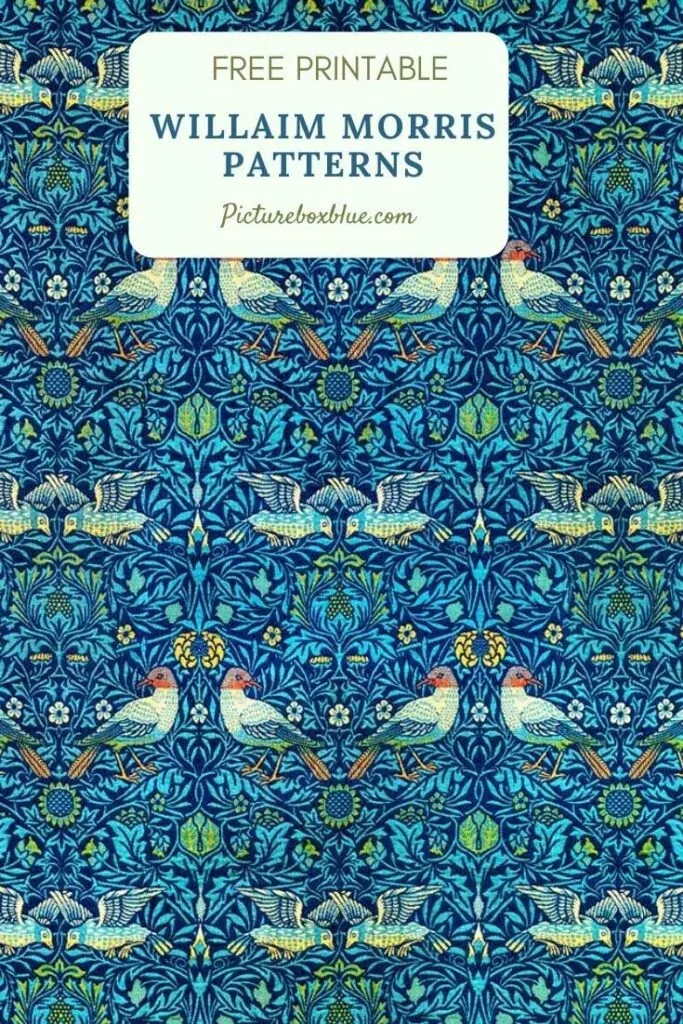
Who was William Morris
William Morris (1834 – 1896) was a very accomplished Victorian British gentleman. He was a gifted textile designer, poet, novelist, translator, and socialist activist. These days, we admire him for his interior design, but he was more famous as an author and poet when he was alive.
Morris was closely associated with the British Arts and Crafts Movement. He significantly contributed to reviving traditional British textile arts and production methods.
The Arts and Crafts movement reacted to the Industrial Revolution at the time. William Morris wanted people to have beautiful things in their homes to improve their quality of life. Ironically, most of his products were unaffordable to the average man. This was mainly due to their laborious craftsmanship. Morris liked to use traditional methods and natural dyes with his designs.
William Morris’s patterns and designs show his inspiration from nature. His textile patterns and wallpapers incorporate plants, fruits, flowers, and leaves, much like Maurice Verneuil’s art nouveau prints.
The most famous William Morris quote is, “Have nothing in your house that you do not know to be useful or believe to be beautiful.”
William Morris was influenced by Martin Gerlach and his book “The Plant in Art & Crafts”; check out his stunning vintage plant art here.
The Designs and Patterns
William Morris produced a wide range of designs for interiors and home furnishings. These included over 600 patterns for wallpaper, textiles, embroideries and over 150 stained glass windows.
He also created three typefaces, about 650 borders, and ornamentation for his private Kelmscott Printing Press.
If you want to see William Morris’s wallpapers and patterns in situ, I recommend visiting the V&A museum in London. His designs are not only part of the museum’s collection but also the décor in the dining room, too, just like Owen Jones’s grammar of ornament designs.
To download the William Morris pattern you want, click on the title above the image. A higher-resolution image will open in a new window in your browser. Right-click the image with your mouse, and the menu option will appear to save it to your device.
1. Blackthorn Wallpaper Design
This William Morris wallpaper pattern features pretty meadow flowers of fritillary, viola, and daisy overlain with the white blossoms of hedge blackthorn. It is still available to buy today.
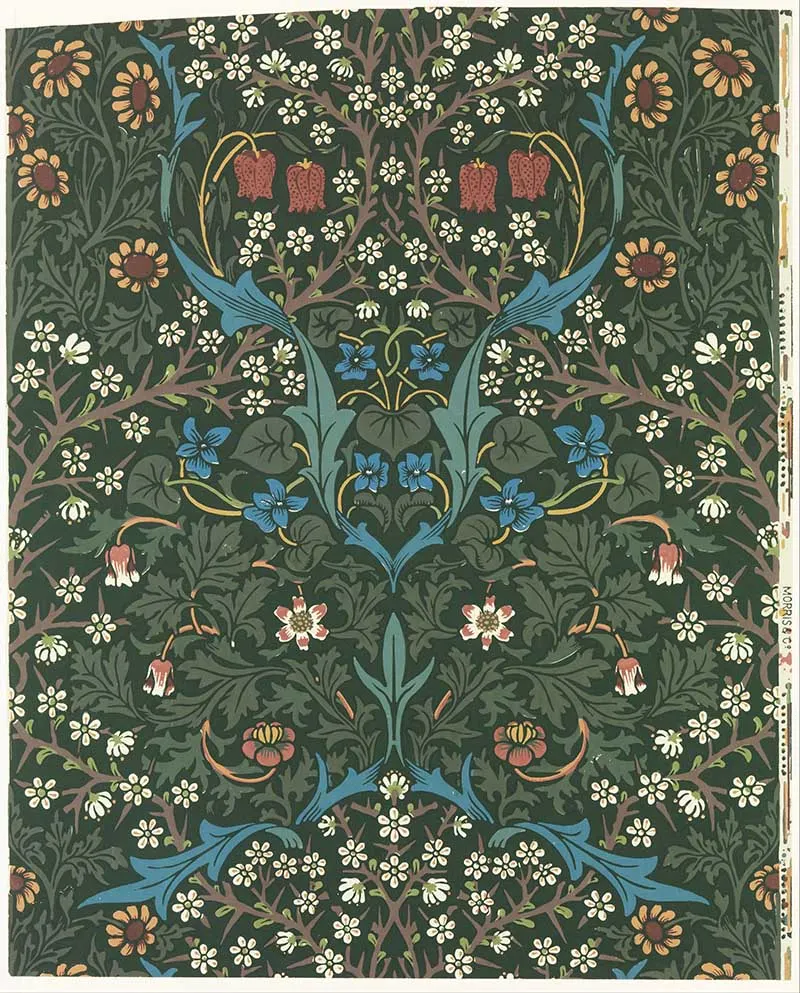
2. Daisy Wallpaper Design
A block printed William Morris design from 1864, ‘Daisy’ wallpaper pattern—a repeating pattern of plants, with red and yellow flowers, with a ground suggestive of grass.
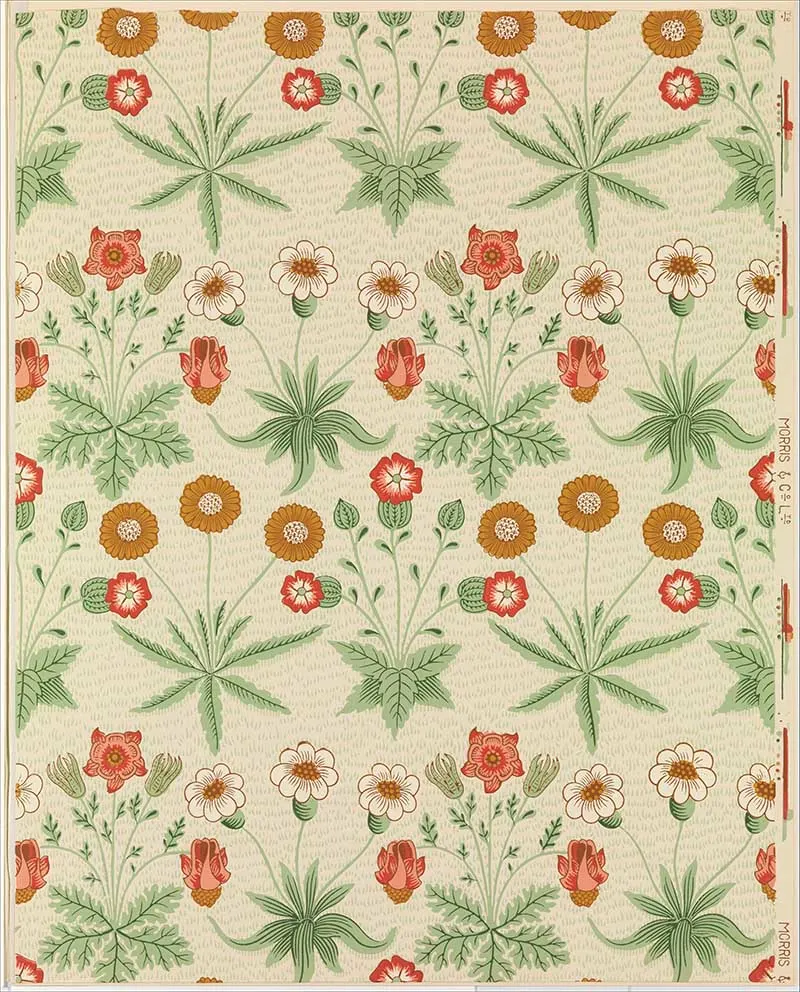
3. Birds Pattern
Morris designed this wallpaper for the walls of the drawing room of his family home, Kelmscott House, London, 1878. I love the vibrant blues of this particular colourway pattern.
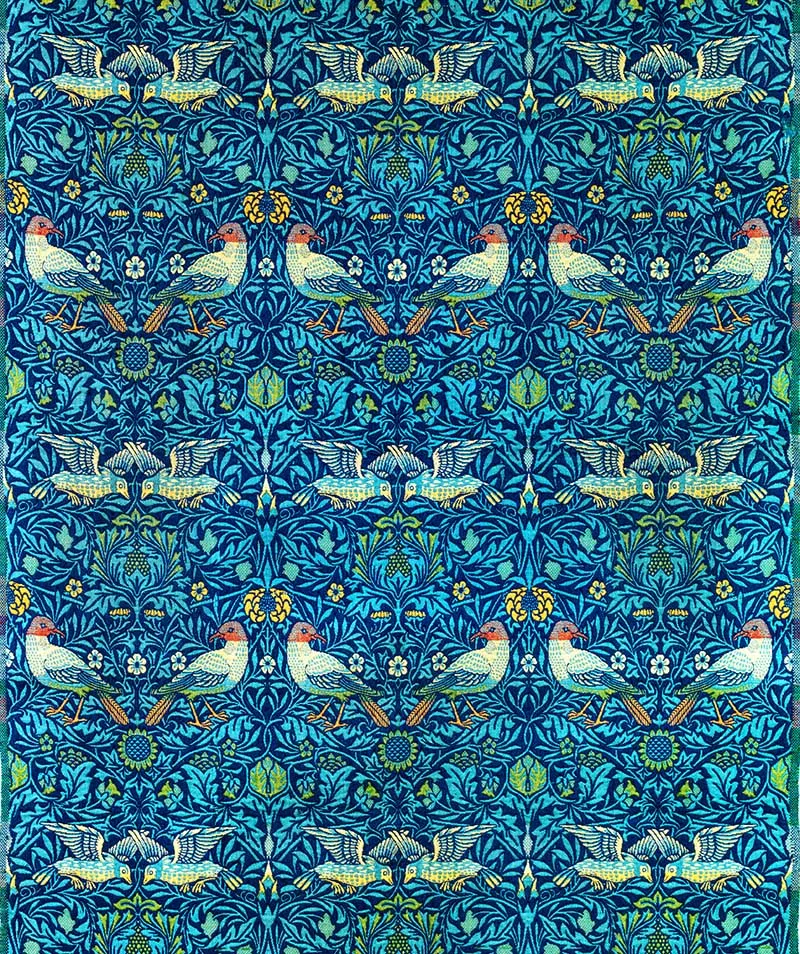
4. Wreath
Original William Morris design for the wallpaper pattern called wreath 1876. This print would look fabulous framed.
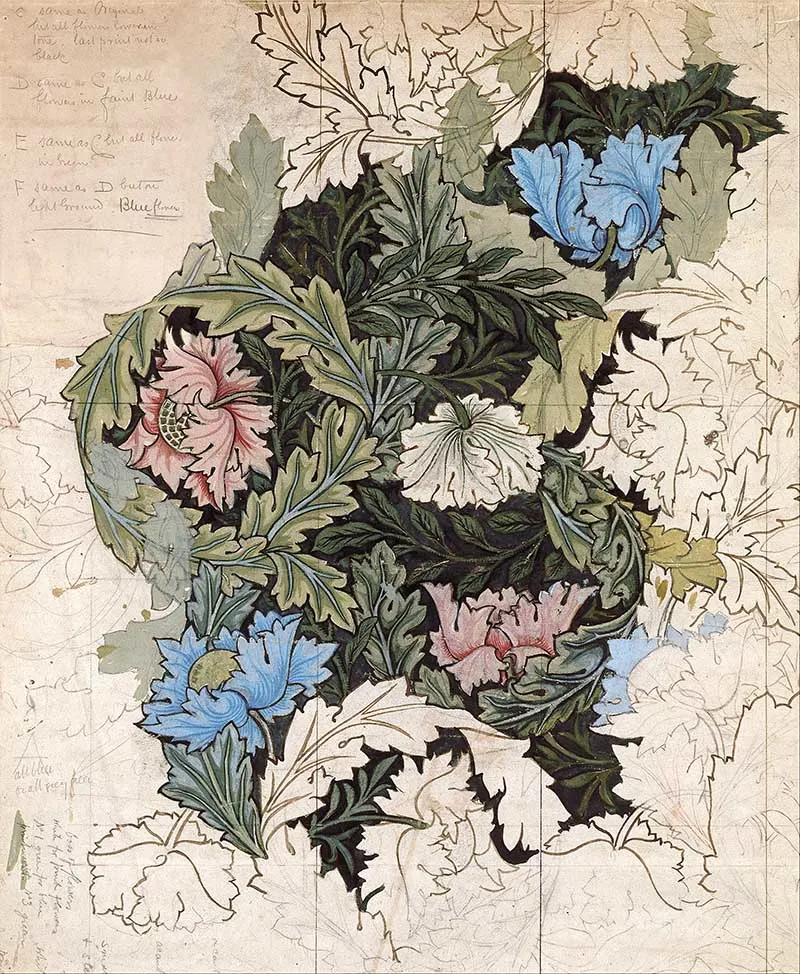
5. Trent
Another beautiful flower print from William Morris that would look lovely framed. This design is called Trent from 1888.
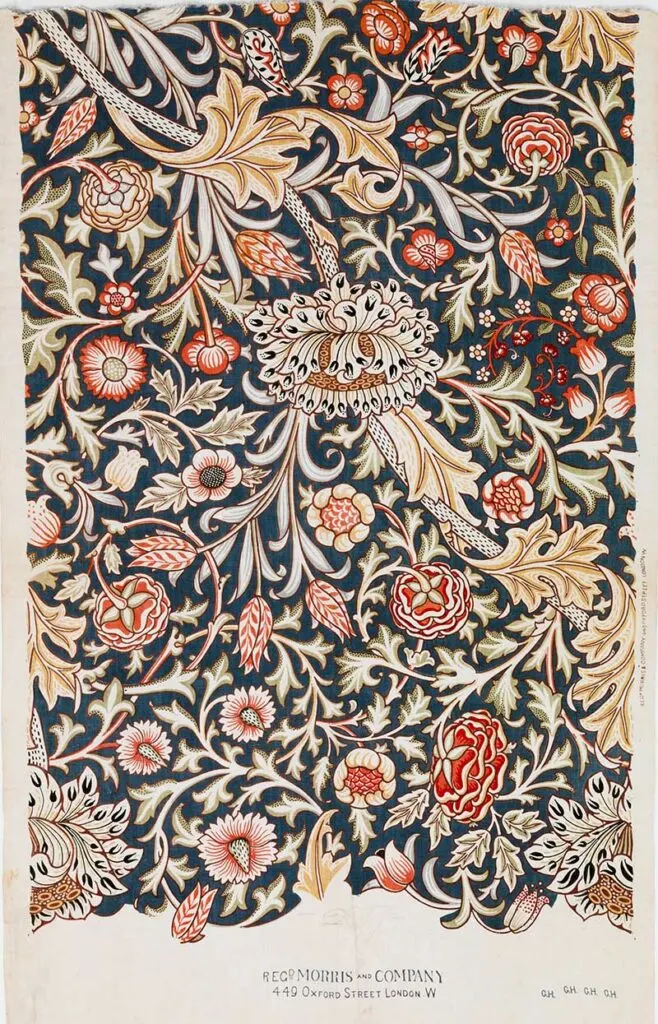
6. Marigold
A delicately complex two-colour leaf and marigold floral design with its undulating vertical stripe effect is typical of Morris. It was designed initially in 1875 but is still available to buy today as wallpaper and fabric in several different colourways.
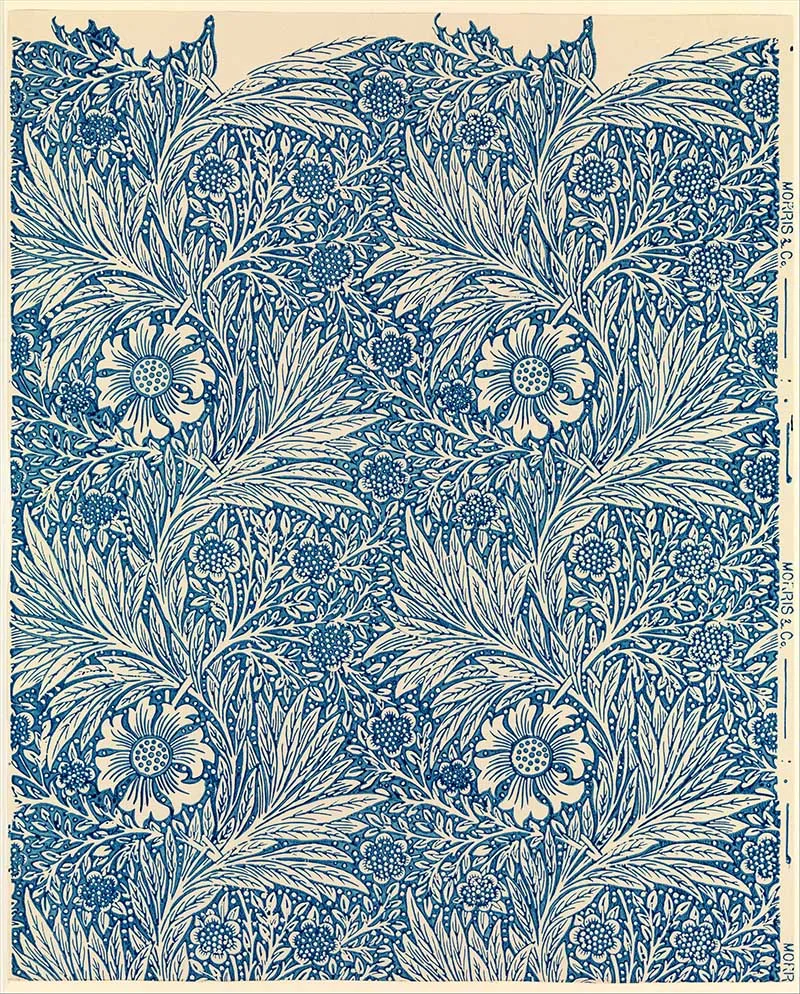
7. Acanthus Portière
Design produced in 1890.
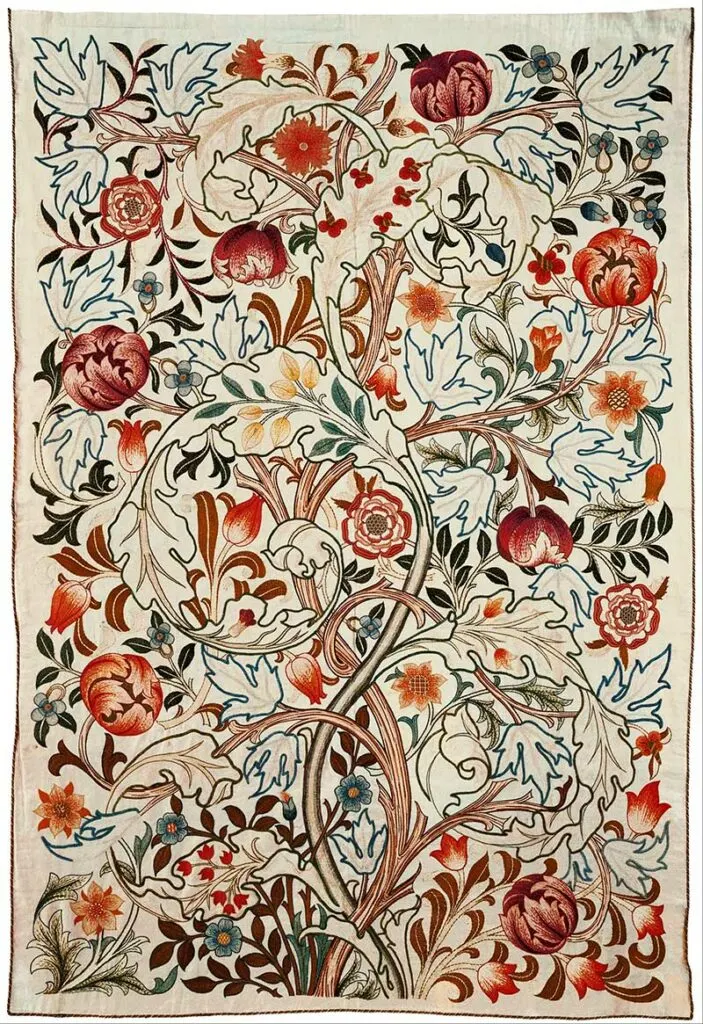
8. Pink and Rose
Pink and Rose’ wallpaper, intertwined stems of flowering carnations and roses made in 1890.
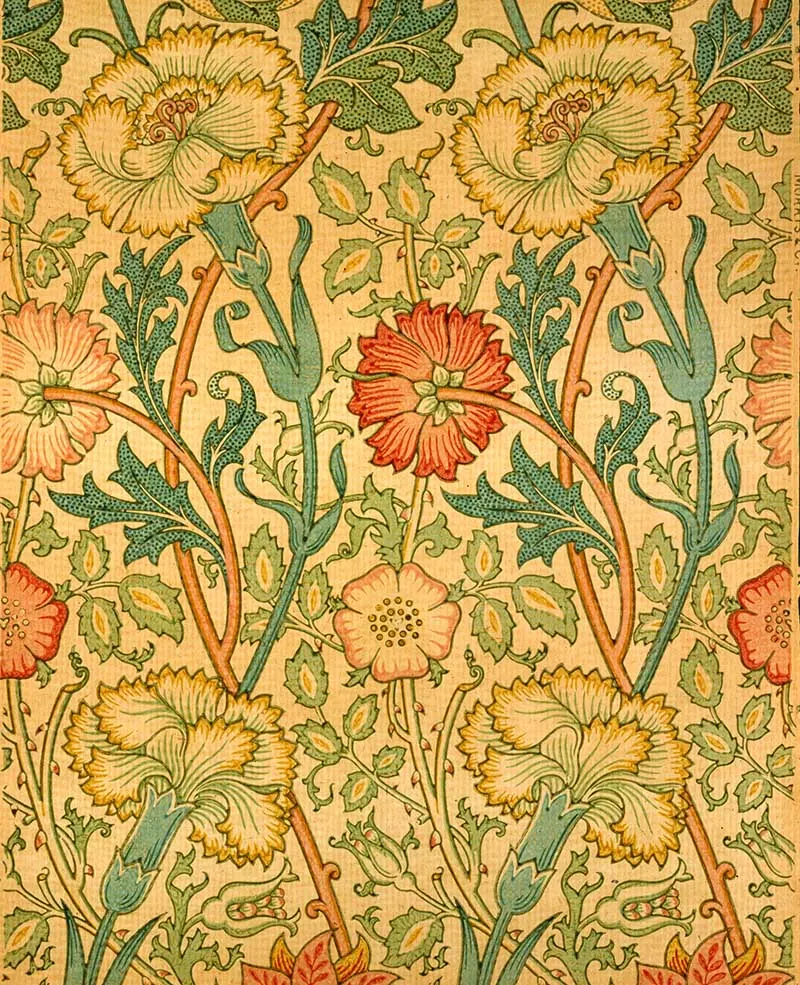
9. Anemone William Morris Designs
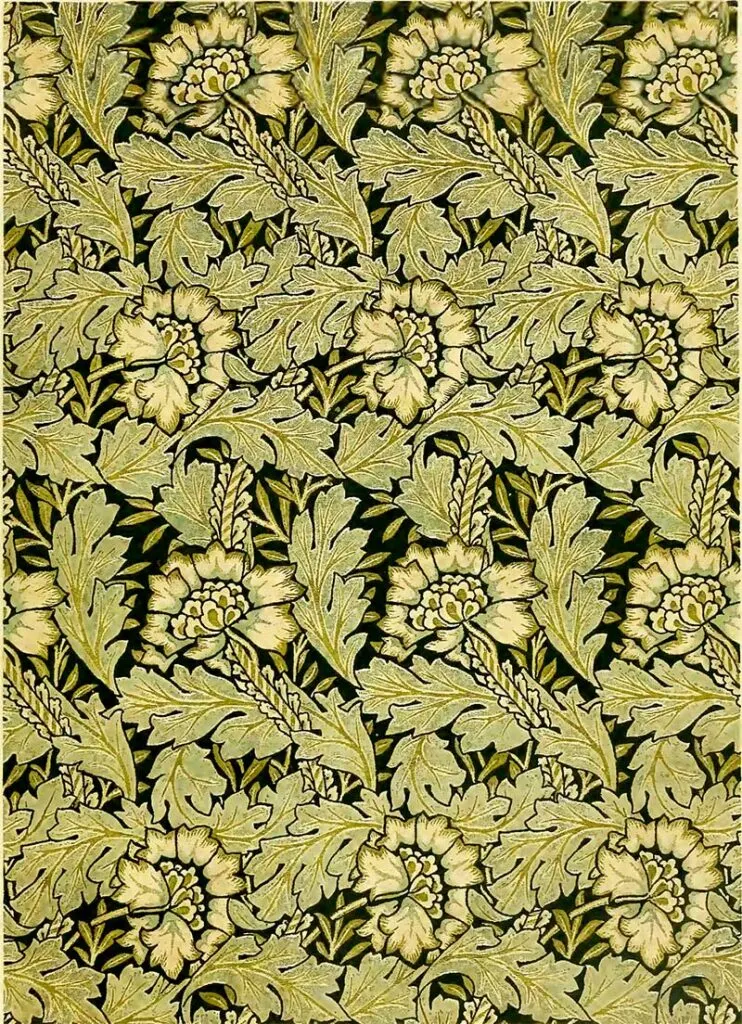
10. Violet and Columbine
An upholstery fabric design by William Morris in 1883.
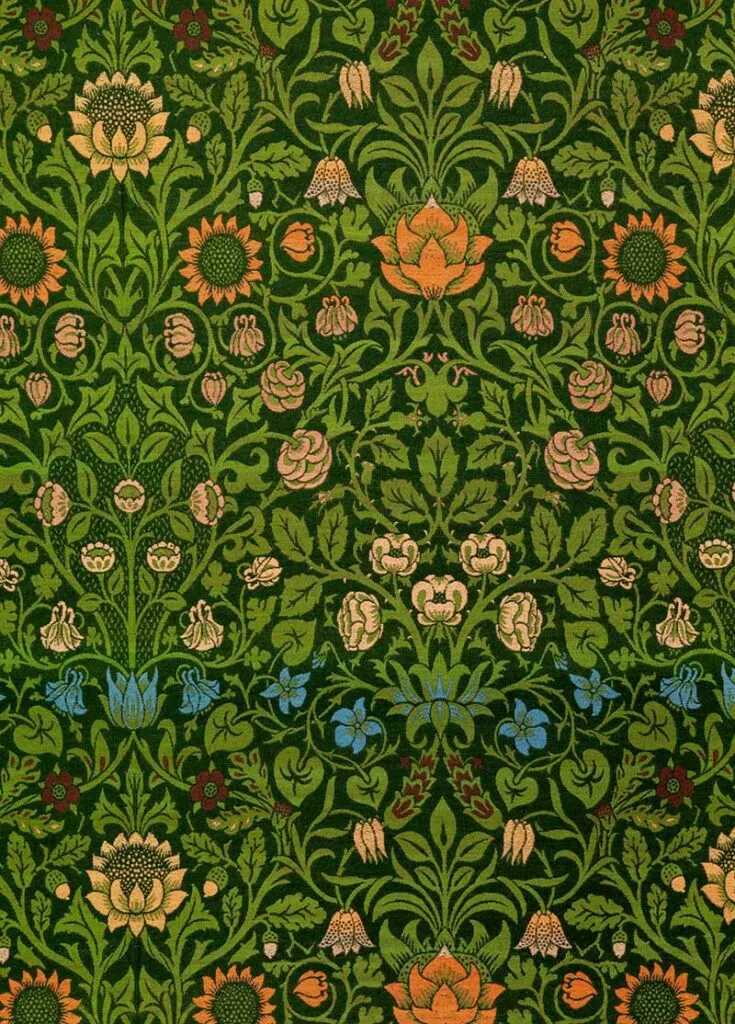
11. Strawberry Thief
Perhaps the most recognizable of Morris’s textiles, Strawberry Thief celebrates the thrushes in his house, Kelmscott Manor’s garden.
His daughter May Morris remarked, “You can picture my Father going out in the early morning and watching the rascally thrushes at work on the fruit beds and telling the gardener who growls, ‘I’d like to wring their necks!’ that no bird in the garden must be touched.”
Morris perfected the indigo-discharge process with Strawberry Thief, which required the whole cloth to be dyed blue before it was bleached and block printed, in this case with more colours than any of his other textiles.
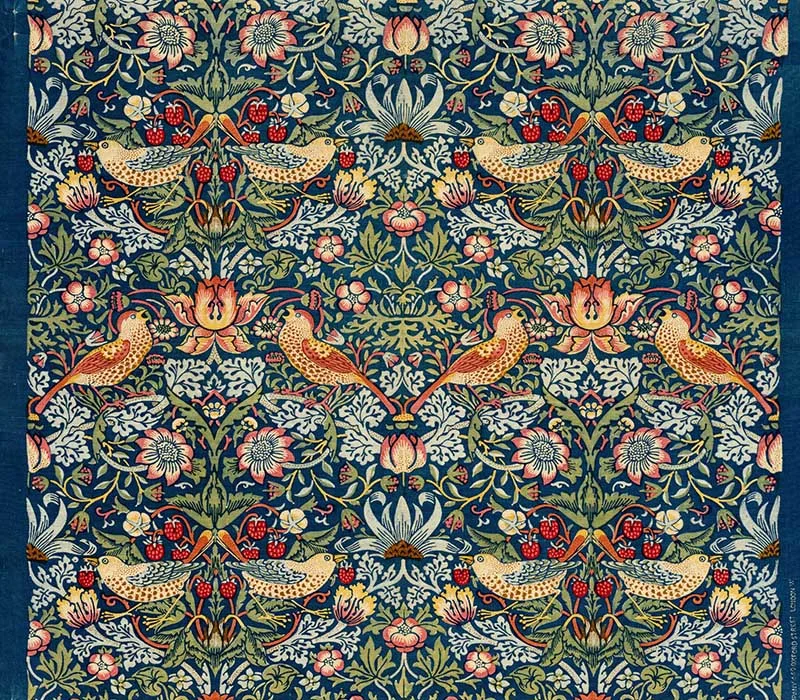
12. Snakeshead
When Morris designed Snakeshead in 1877, Indian silks were in style and widely imported from British India. This design stands out for its small motifs and the solid red and black colours, which were fashionable only briefly before paler hues regained favour with clients.
While its colour scheme suggests distant lands with warmer climates, the pattern showcases one of Morris’s favourite flowers: the fritillary, a wildflower that he remembered growing in the meadows near Oxford.
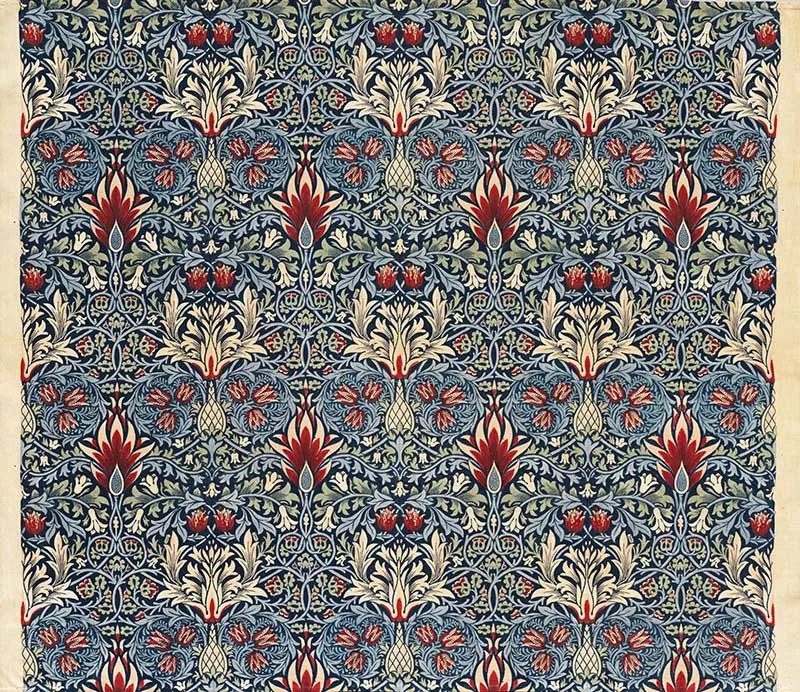
13. Chintz The Wandle Design 1884
The design was inspired by historic textiles, especially fifteenth-century velvets that often featured a solid diagonal or meandering branch from which various flowers emanated.
The design’s title refers to the river on which the Merton Abbey textile mill was situated. The river was a crucial power source and clean water for textile processing.
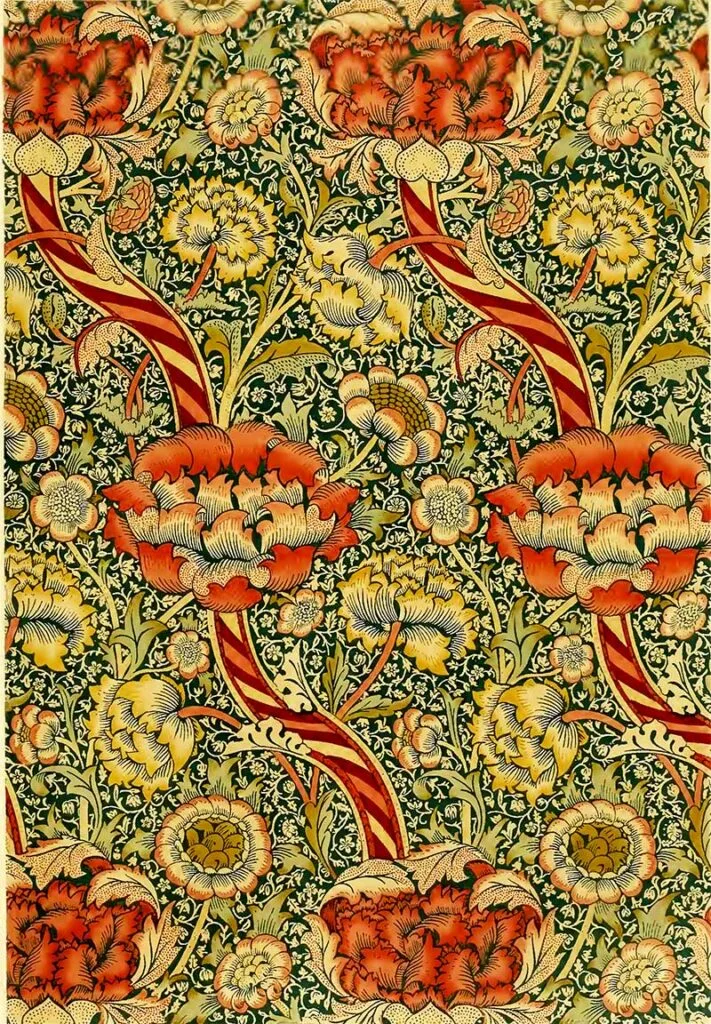
14. Chintz The Wey Design 1884
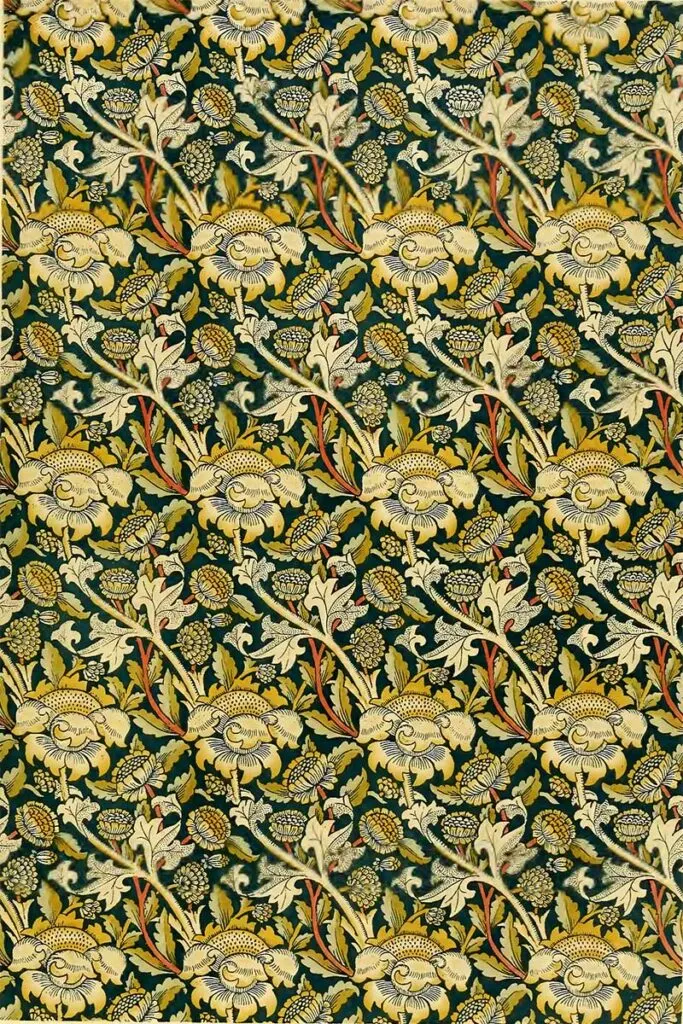
15. William Morris Honeysuckle Design
Archival research revealed that this design was by William Morris’s daughter, May. Originally designed in 1883, it is still a popular wallpaper design today.
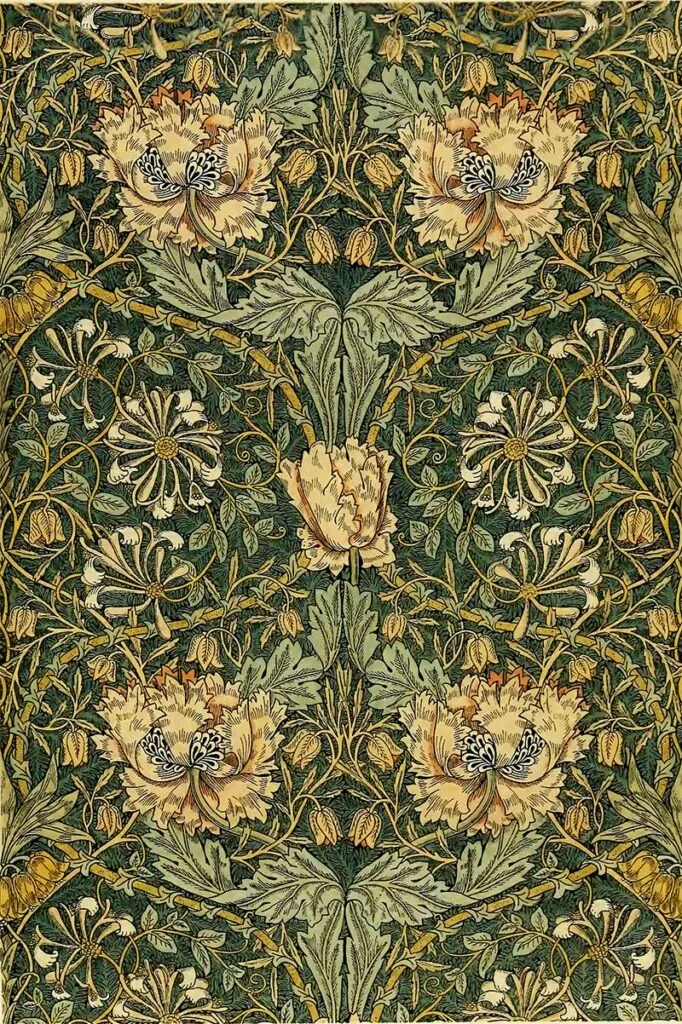
16. Tulip Design
A William Morris pattern of flowering tulips with other flowers and foliage.
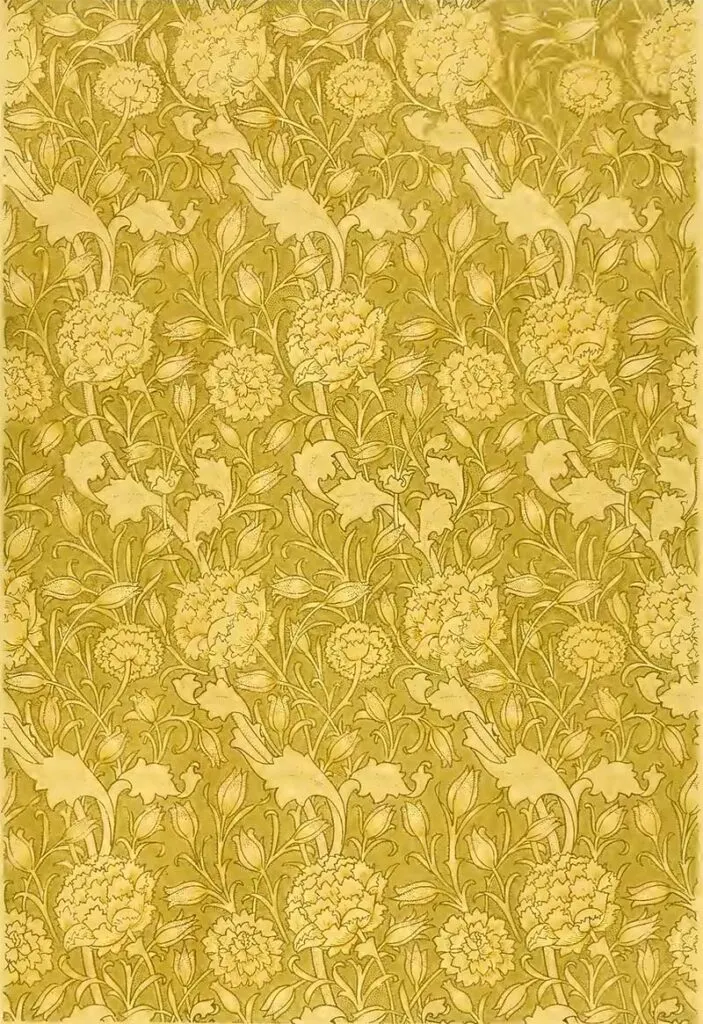
17. William Morris Trellis Pattern
Trellis is the first wallpaper Morris designed, but the second one he produced. He simplified the trellis into perfect squares, sketched in some lines simulating woodgrain without suggesting depth, added some climbing roses and bluebirds, and created a classic.
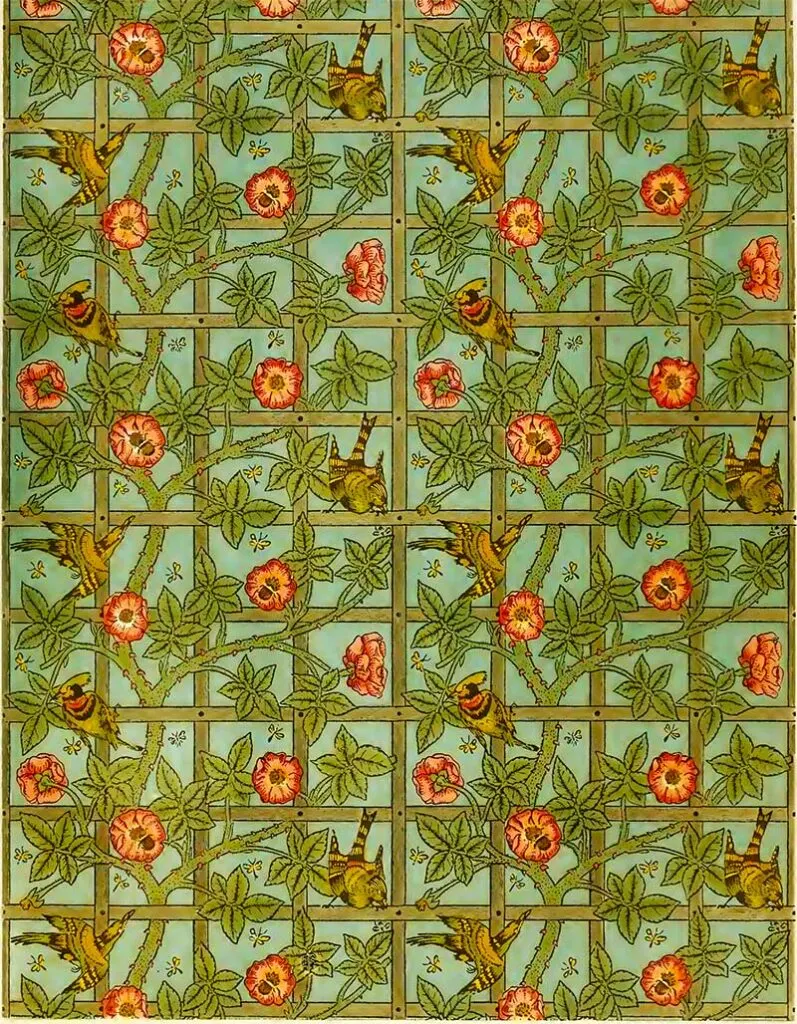
18. Wallpaper St James Palace
‘St James’s’ was designed for the Grand Staircase in St James’s Palace. The decorative scheme for the palace was begun in 1866. It was Morris & Co.’s first secular commission.
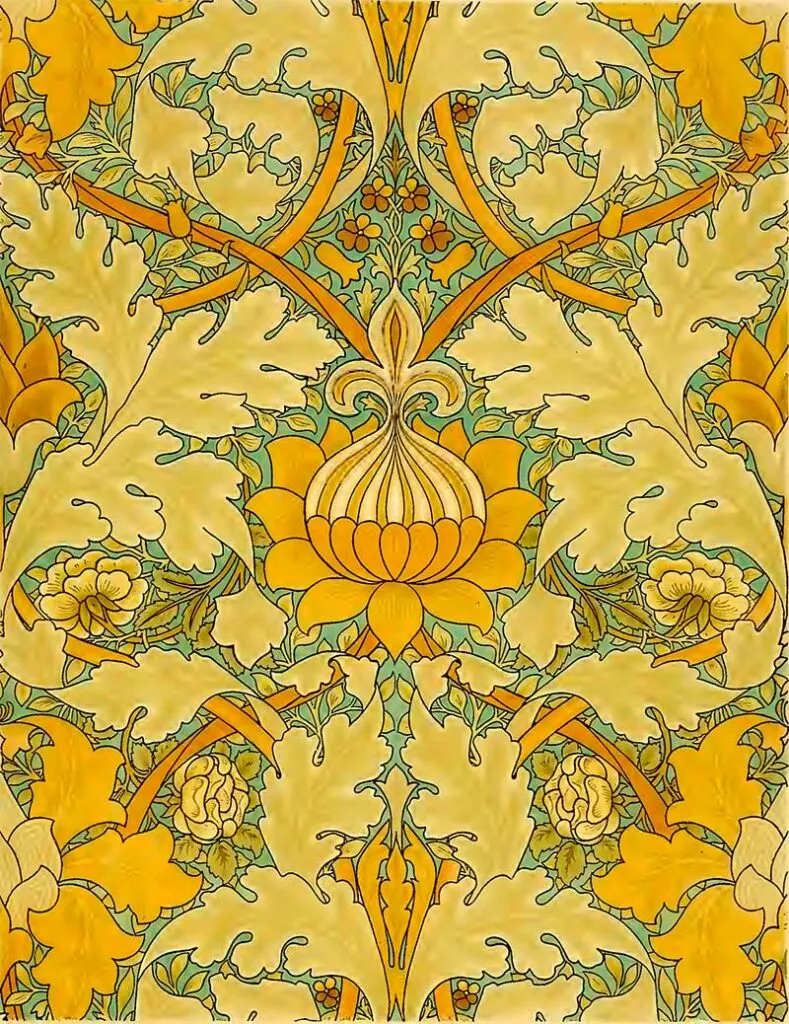
19. Cherwell Design
A meander pattern of chrysanthemums, carnations roses and thistles, named ‘Cherwell’ 1887.
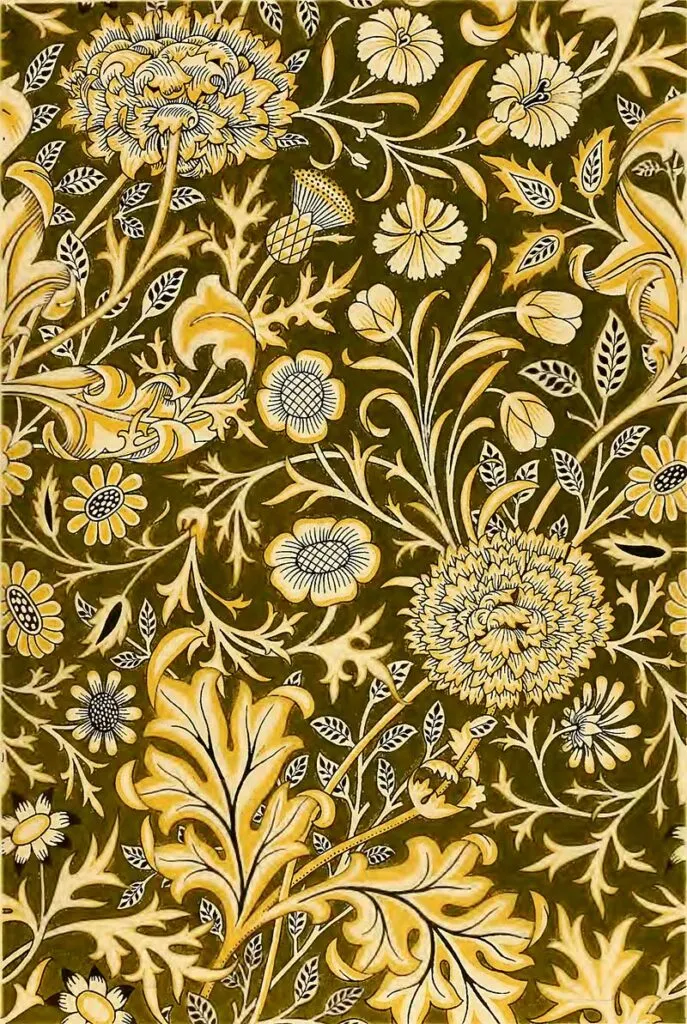
20. Velvet Broche
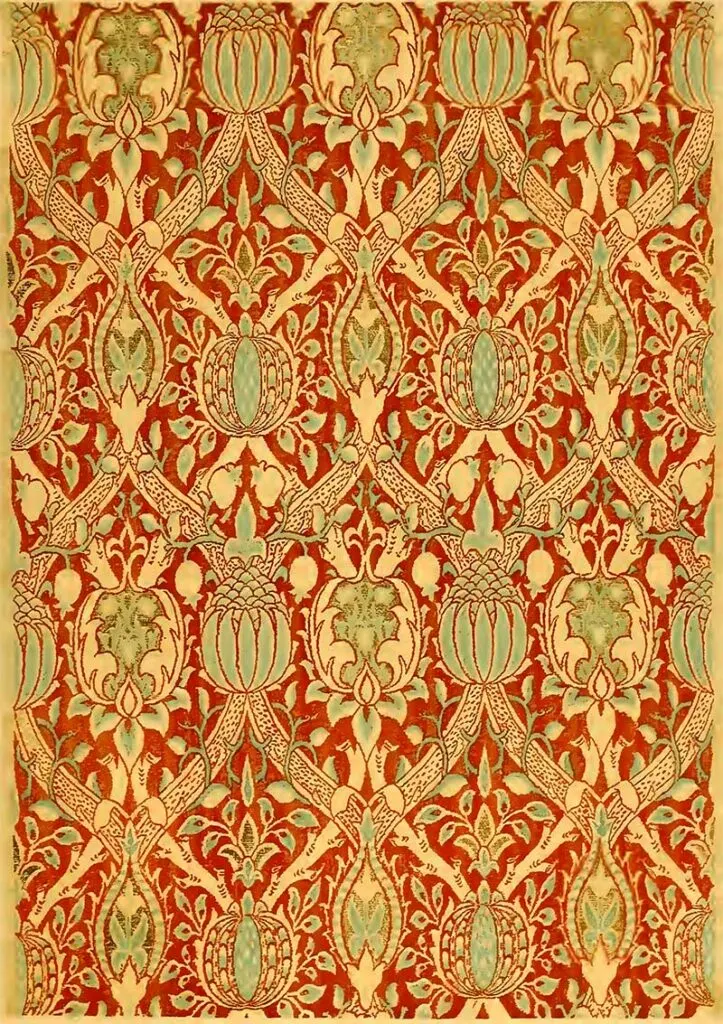
21. Greenery Tapestry
A Morris & Co tapestry. Designed by John Henry Dearle in 1892, imitating William Morris’s style in the trees. Dearle was a British textile and stained-glass designer trained by William Morris. I thought I’d still include it here as it is so beautiful.
This tapestry was woven at the Merton Abbey Tapestry Works. William Morris founded the workshop at Merton, in Surrey, near London, in 1881 as part of his vision to use traditional craftsmanship to revitalize the art and design of postindustrial Britain.
(This image was used for the DIY tea light lanterns craft)
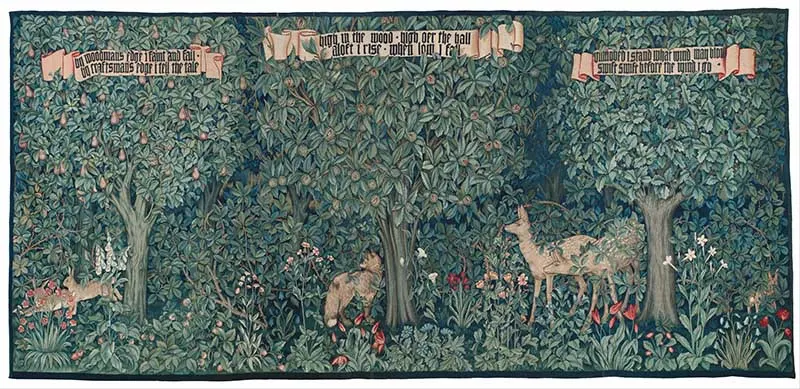
22. William Morris Flower Pattern Pimpernel
A William Morris design is named Pimpernel after the small pimpernel flowers within it rather than the large poppies that dominate it. Pimpernel can be seen in the Billiard Room at the beautiful Wightwick Manor.
This is one of the retro patterns used on these free printable Christmas ornaments.
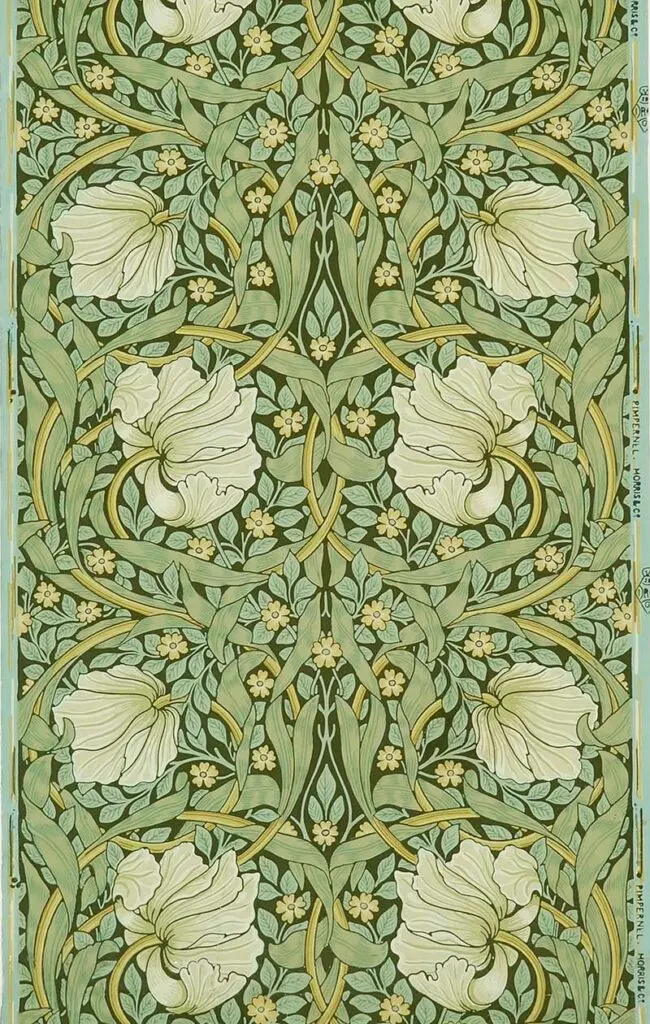
23. Fruit Pomegranate Wallpaper Design
‘Fruit’ is one of William Morris’s most enduringly popular designs. It was used in many artistic homes of the period and is still available from Morris & Co.
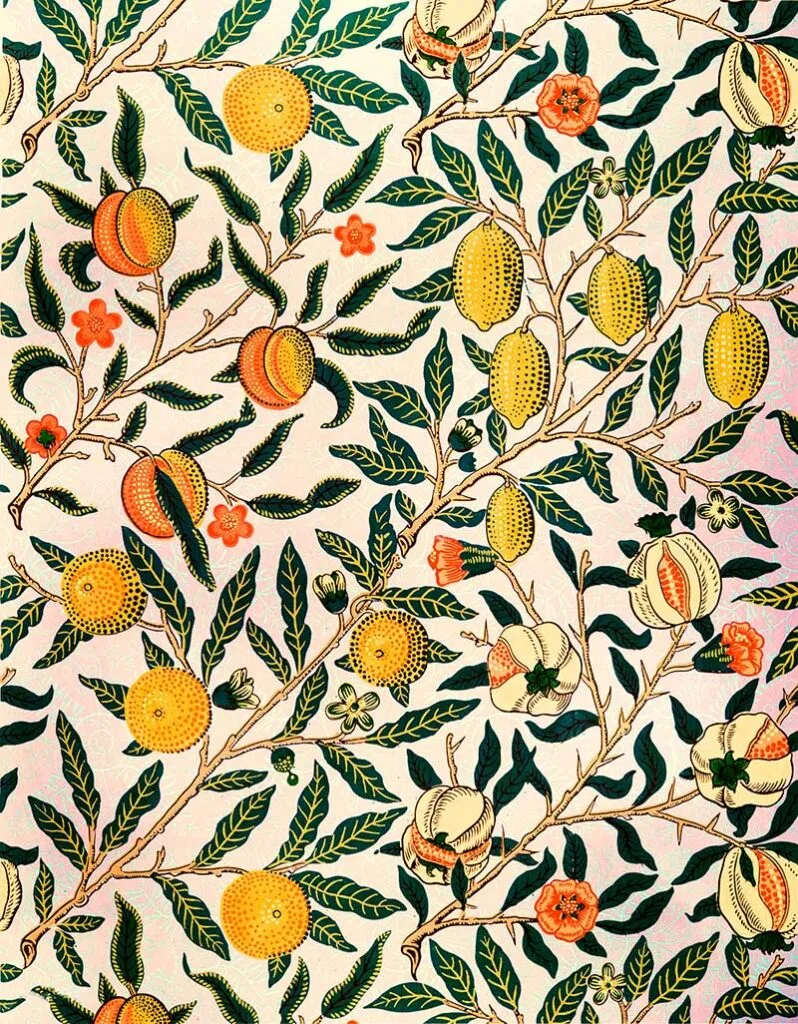
24 Poppy Wallpaper
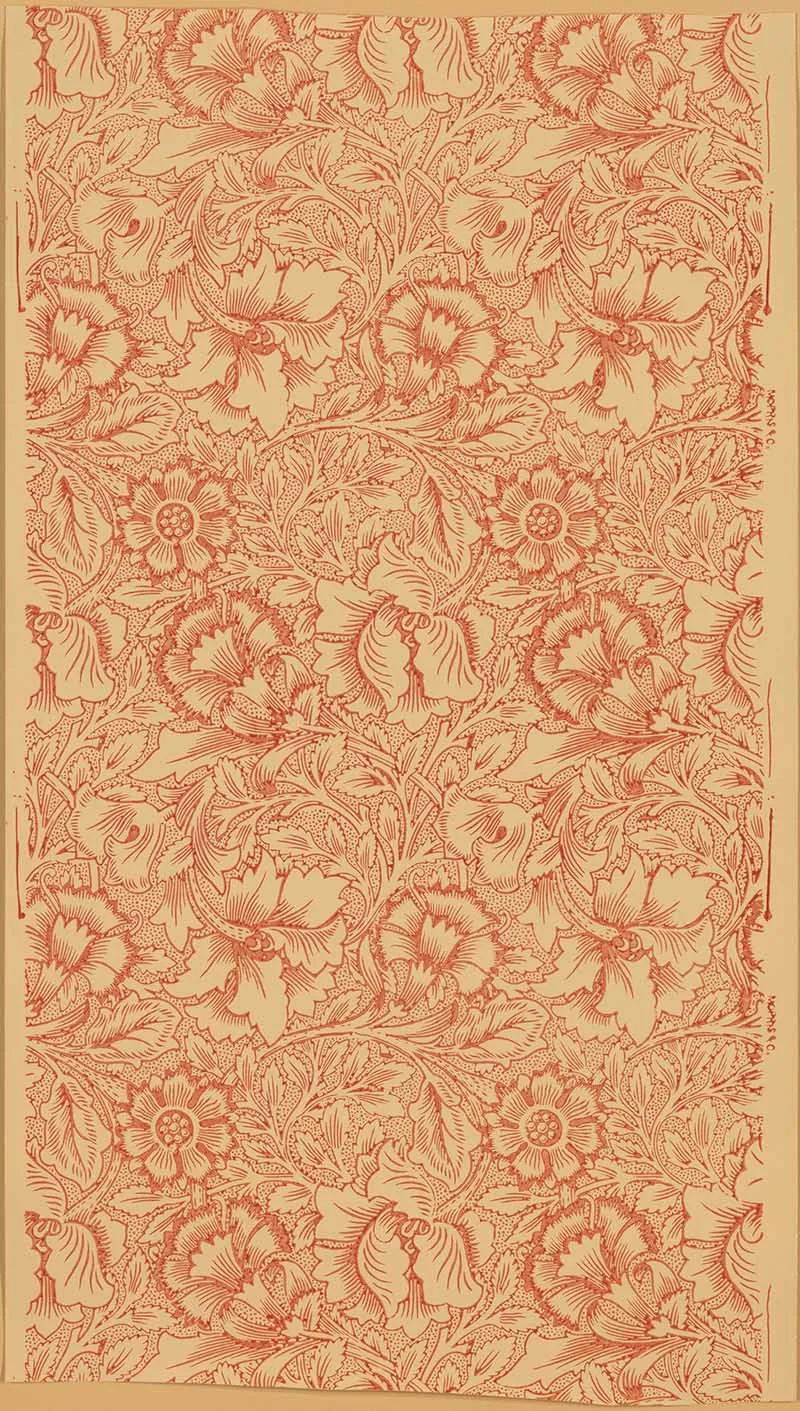
25. Willow bough wallpaper 1887
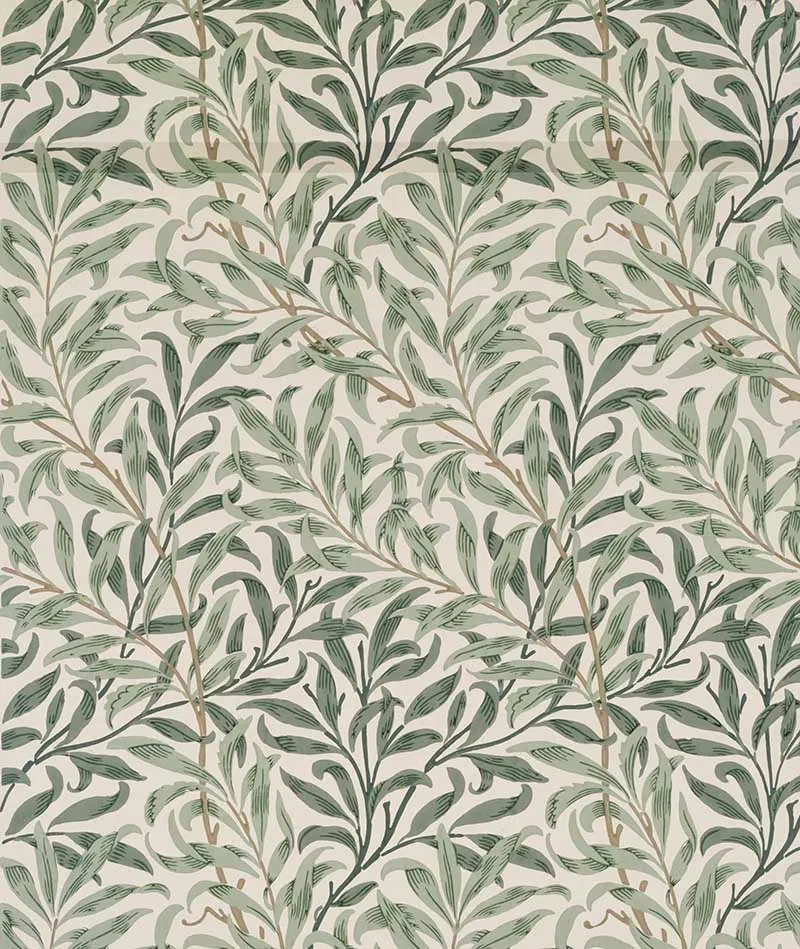
26 Diaper Wallpaper In Green
William Morris’s Diaper Wallpaper features a repeating geometric pattern inspired by medieval tapestries and nature. It showcases stylized flowers and leaves in a grid-like formation. This design reflects his dedication to integrating art into everyday life, using traditional block-printing methods and muted colour palettes to create a harmonious, handcrafted aesthetic.
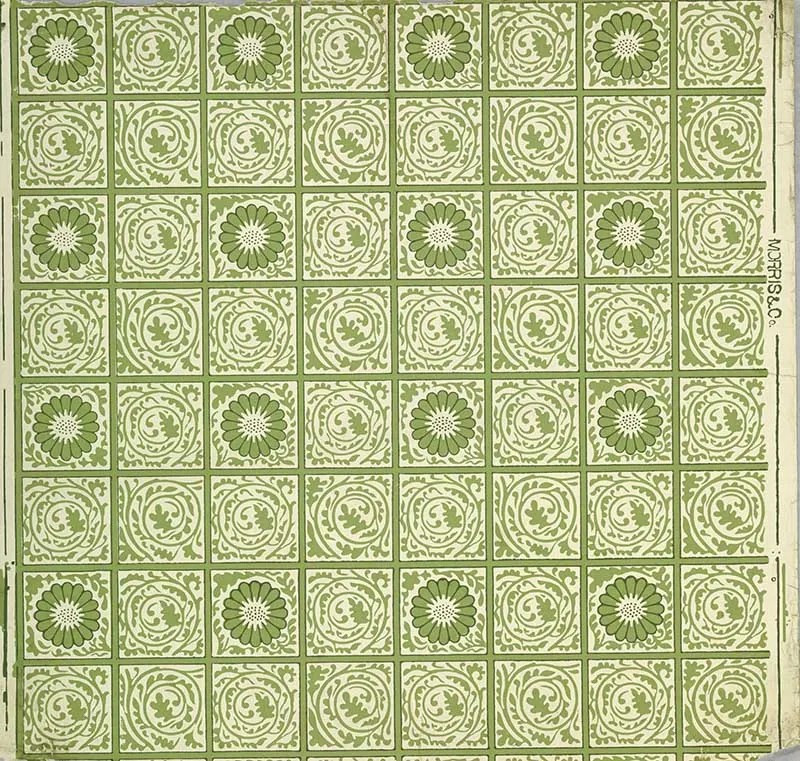
27. Chrysanthemum (1877)
The Chrysanthemum (1877) by Morris & Co. showcases lush, swirling chrysanthemums, capturing the essence of nature’s beauty through intricate, hand-drawn patterns. With rich, earthy tones and meticulous block printing, this design epitomizes William Morris’s vision of turning everyday interiors into works of art rooted in the elegance of the natural world.
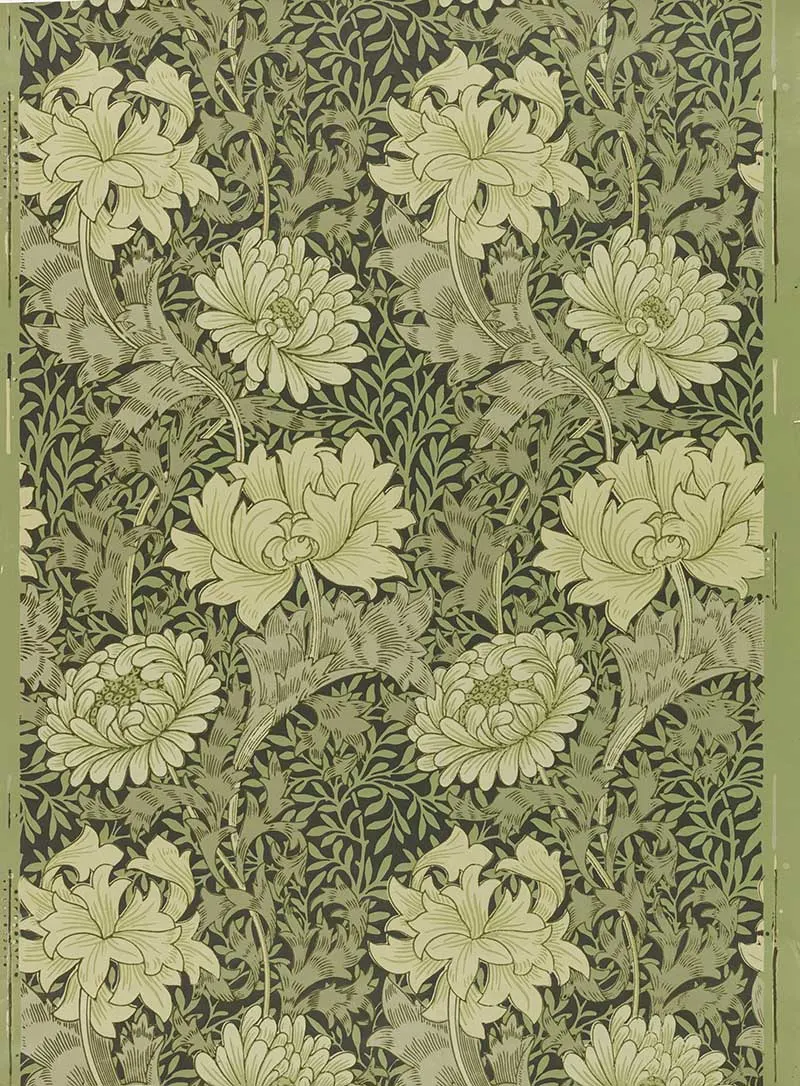
28. Larkspur
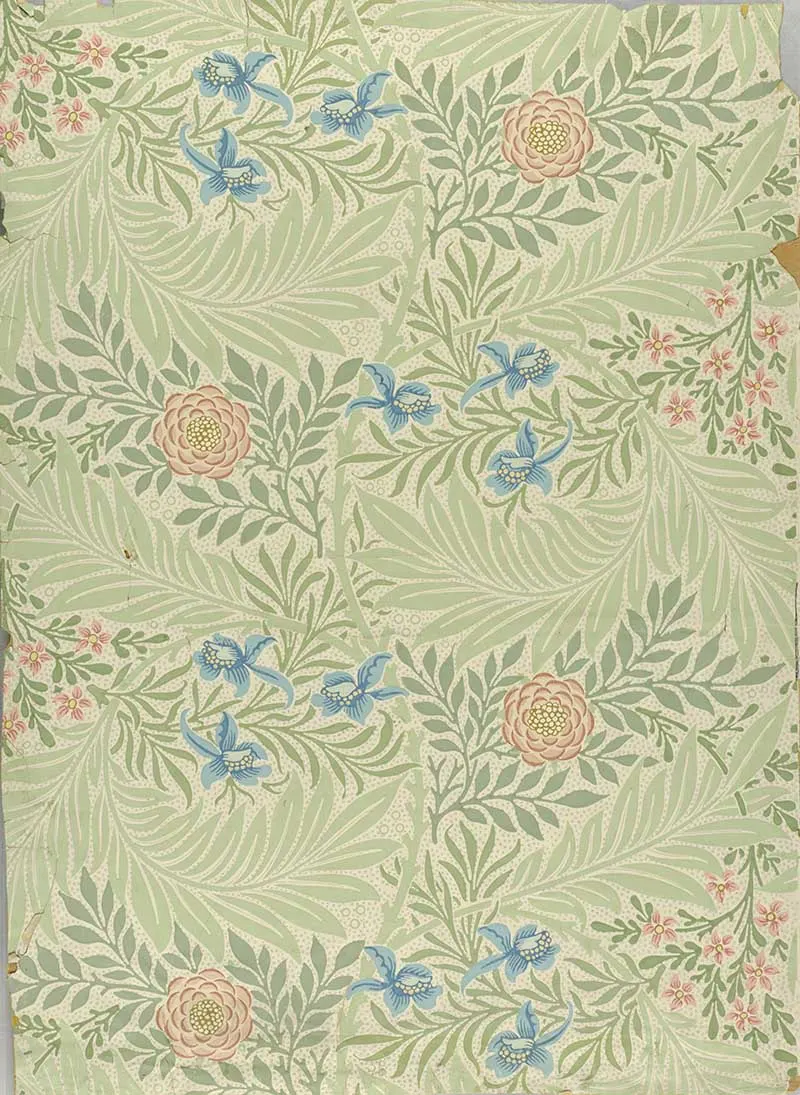
29. Mallow 1879
The Mallow Wallpaper by William Morris features delicate, stylized mallow flowers intertwined with leafy stems in a repeating pattern.
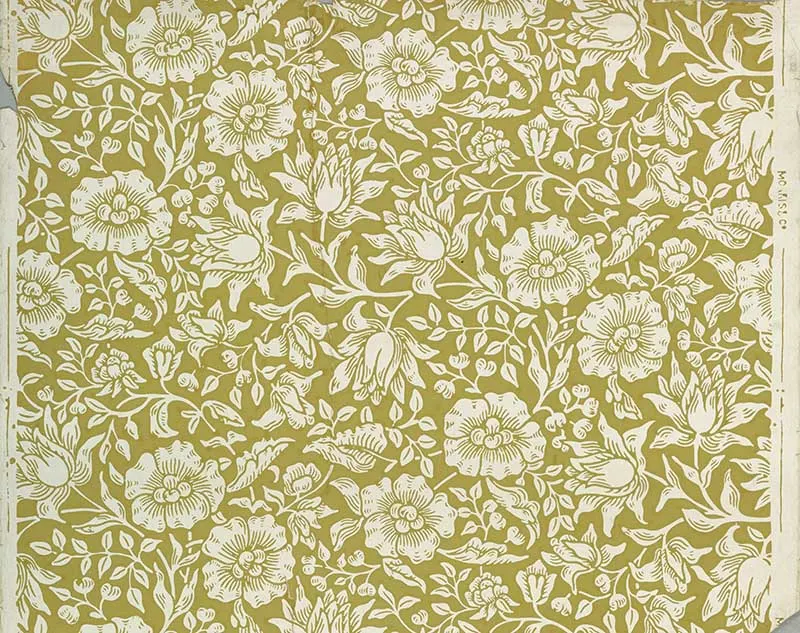
30. Net Ceilling Paper 1895
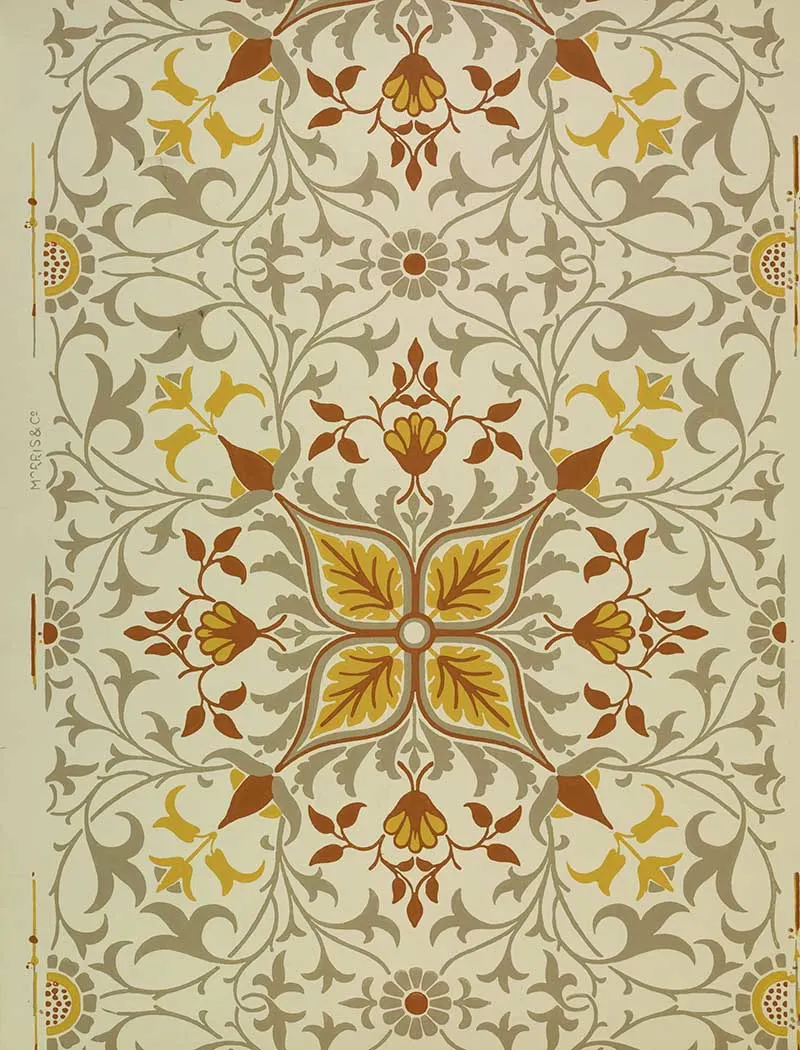
31. Vine Wallpaper
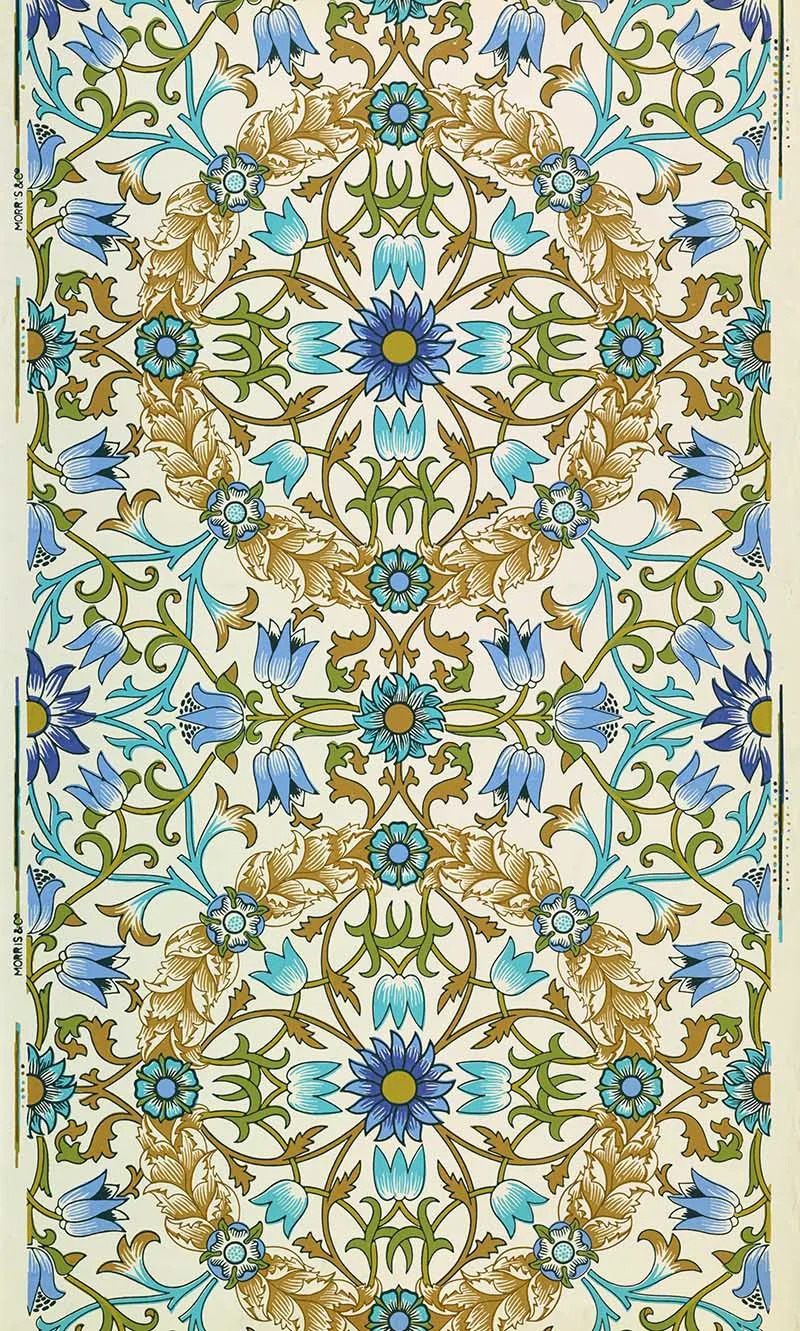
32. Celandine
Alternating horizontal rows of clusters of flowers, including Lily of the Valley and Bluebells, surrounded by bower-like vines. Printed in blue, salmon and green on off-white.
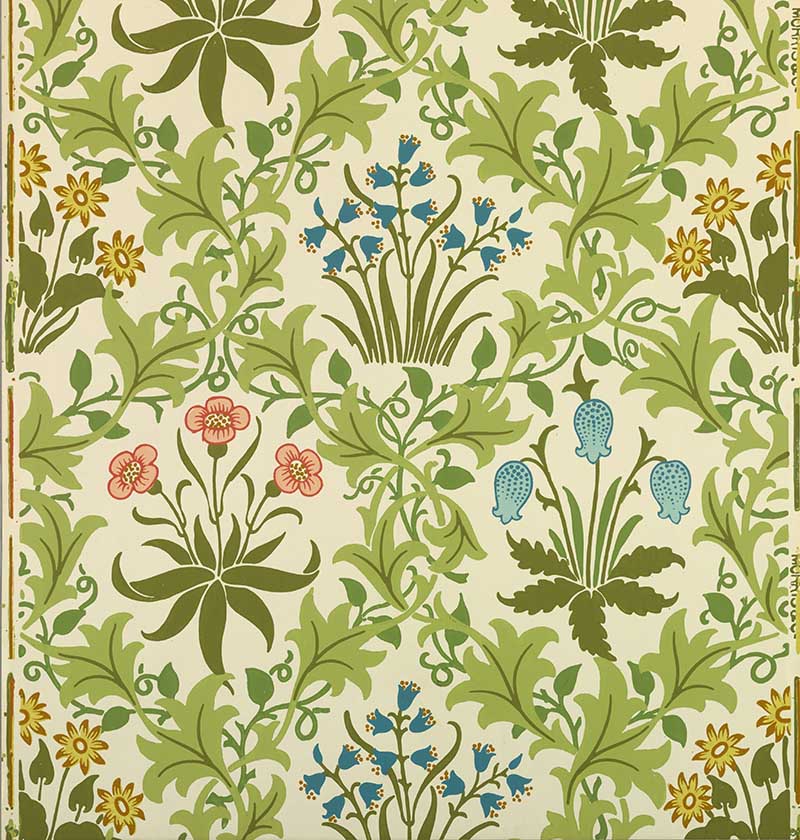
33. Golden Lily
Lillies with fleur-de-lis petals and foliage arabesque. The flowers have faint floral patterns as well. They are printed in green, red, blue, and yellow on a cream ground.
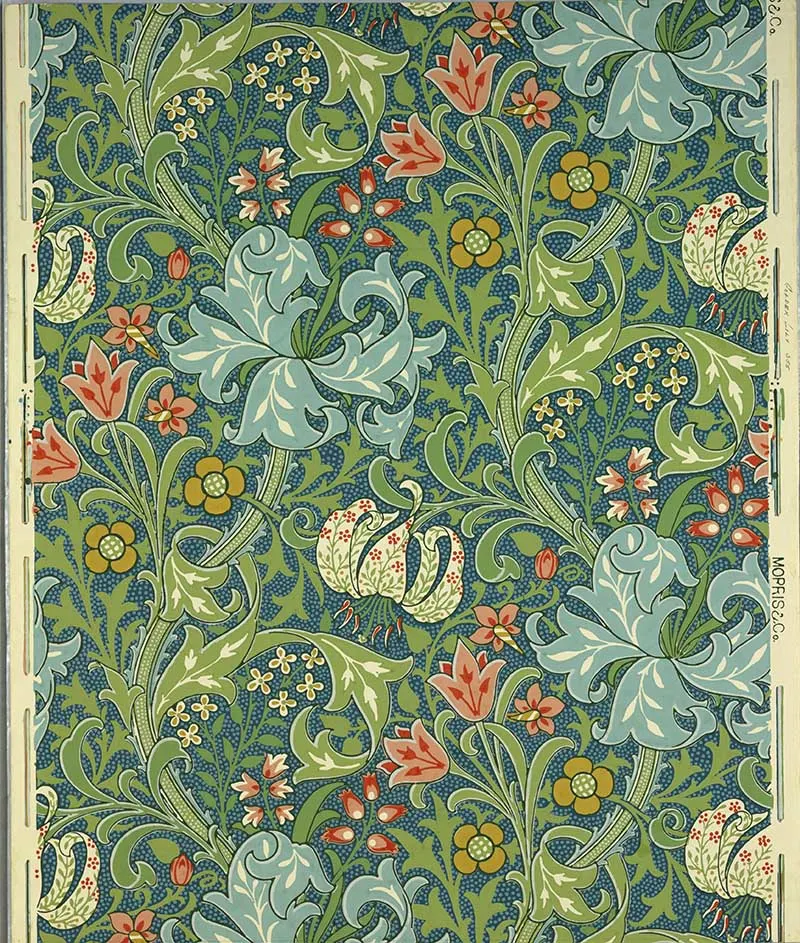
34. Single Stem
Flowers and scrolling foliage with pale foliage arabesque underlay. Printed in orange, blue and green on cream ground.
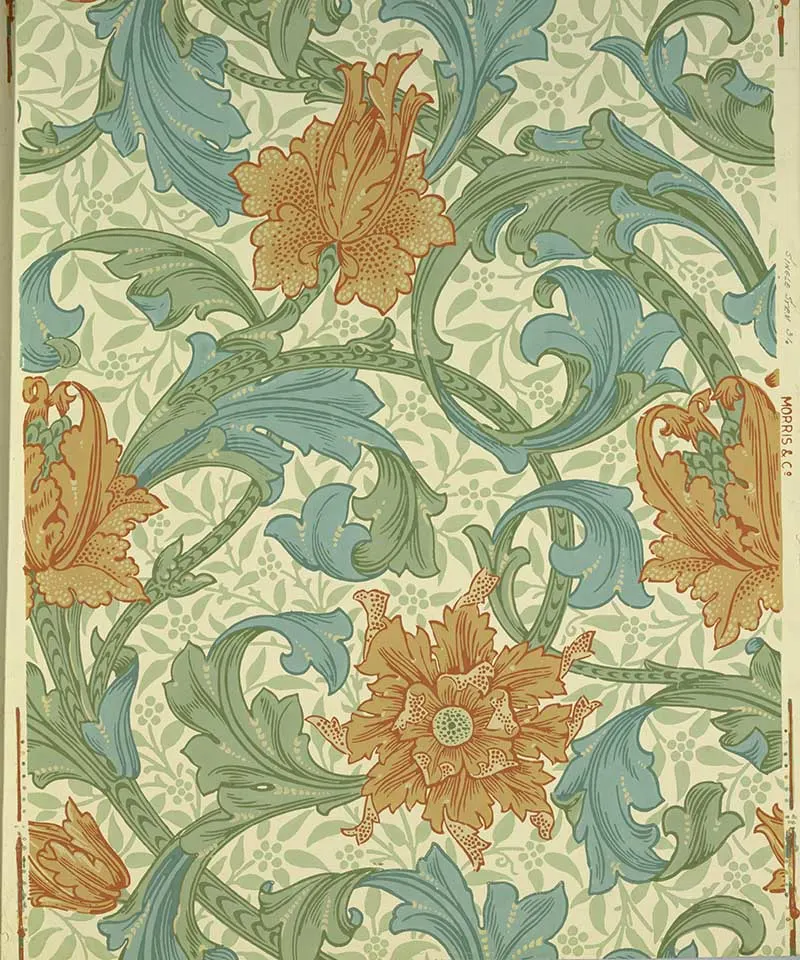
35 Honeysuckle Wallpaper
William Morris’s wallpaper of scattered honeysuckle flowers, narrow wispy petals, and foliage.
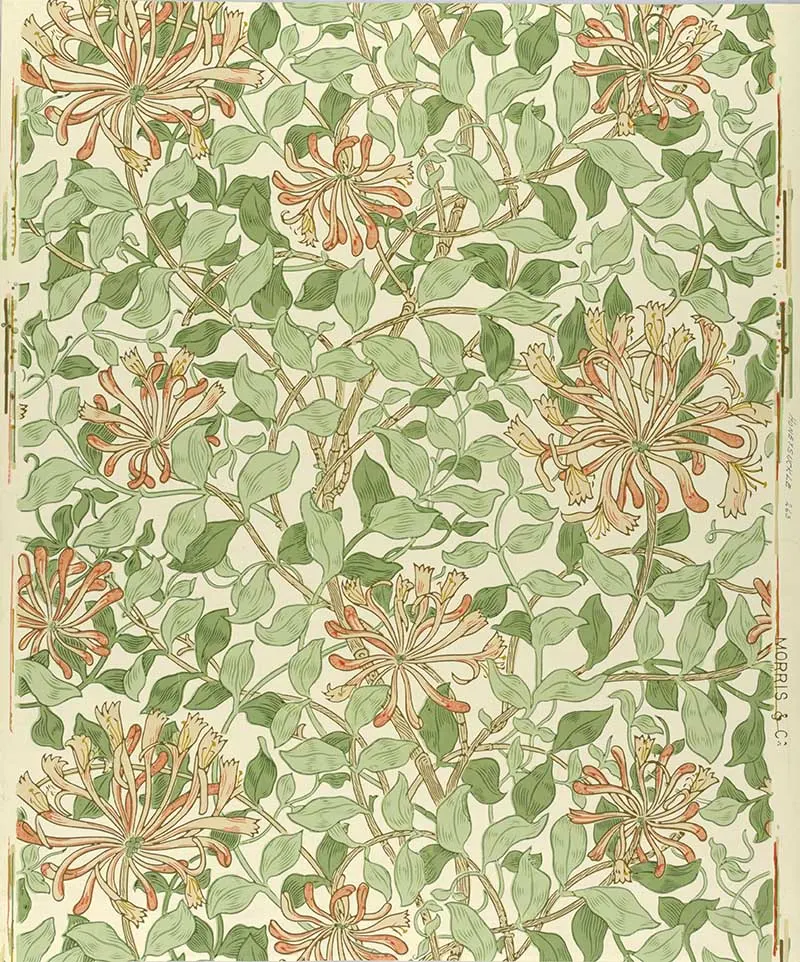
36. Acorn Wallpaper
Acorns and oak leaves are interspersed with a vine and flowers.
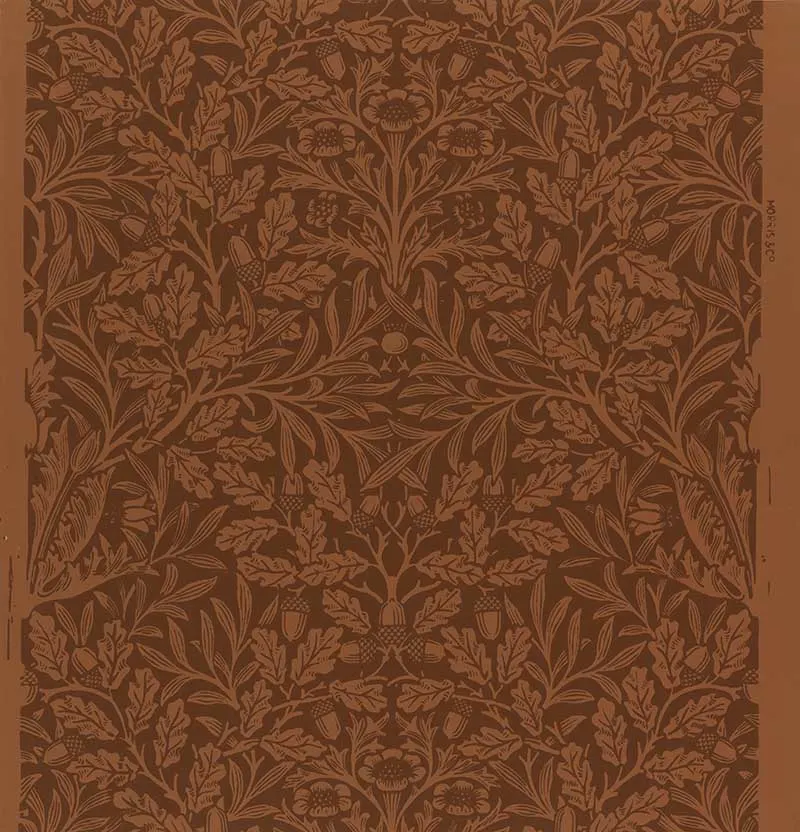
37. Cray – Blue Red Textile
“Cray” is a richly detailed textile pattern designed by William Morris in 1884, named after the River Cray in Kent. It features an elaborate arrangement of scrolling foliage, stylized flowers such as poppies and anemones, and intertwining stems in a vertical flow that reflects Morris’s love of nature and medieval design. Initially, it was printed using wood blocks in deep, earthy colorways. Though created for textiles, “Cray” has since been adapted for wallpaper, home furnishings, and fashion and remains a celebrated example of Morris’s enduring legacy.
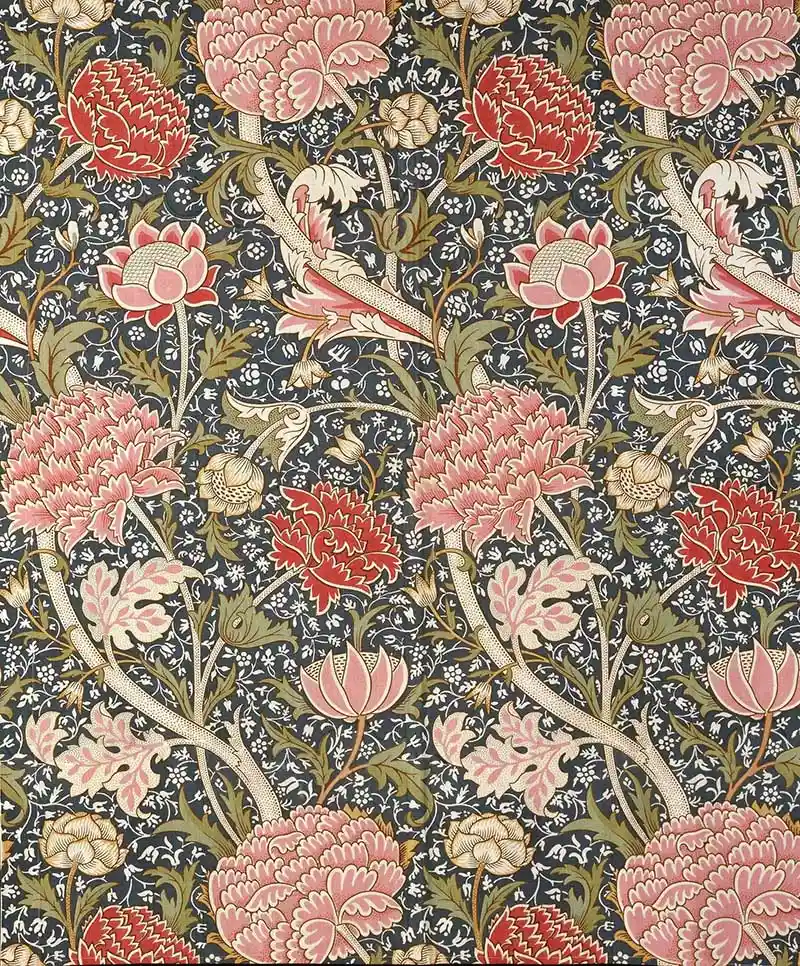
38. African Marigold
The African Marigold (1876) is a lesser-known but beautifully vibrant design by William Morris, showcasing his signature use of stylized natural forms and rich botanical detailing. It features bold marigold blooms with flowing leaves and tendrils, arranged in a symmetrical, decorative pattern typical of Morris’s later works.
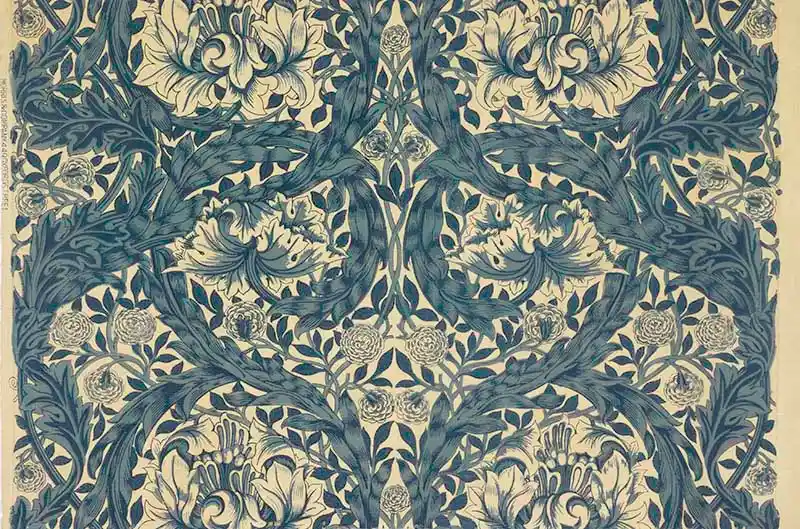
Brer Rabbit is a charming and whimsical William Morris pattern first designed in 1882. Inspired by the American folktales of Br’er Rabbit, the design features stylized rabbits surrounded by dense, leafy foliage and floral motifs. Initially intended for textiles and later used for wallpapers, it reflects Morris’s love of storytelling, nature, and intricate repeating patterns, blending narrative and design in a playful and sophisticated way.
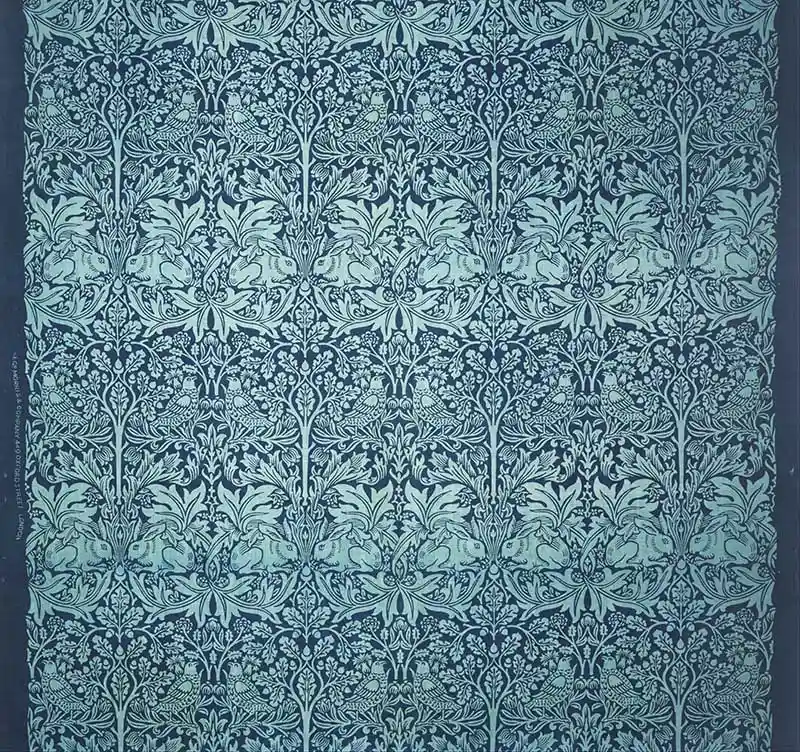
40. Bachelors Button
Bachelor’s Button is a 19th-century textile design by William Morris featuring stylized cornflowers (also known as bachelor’s buttons) intertwined with graceful foliage, arranged in a flowing, symmetrical pattern.
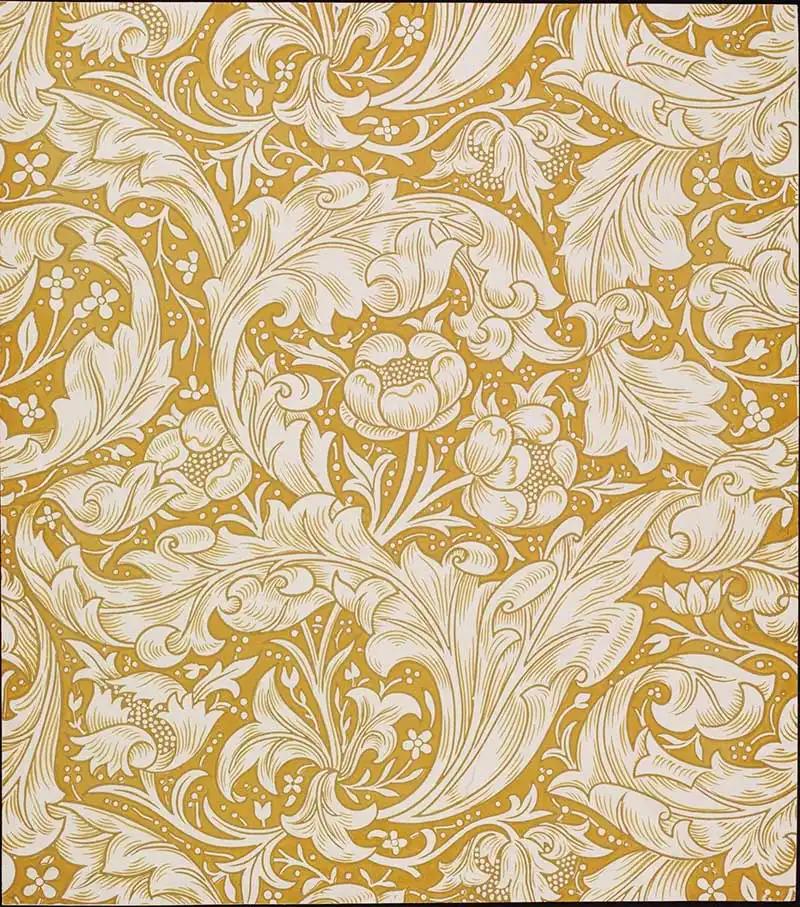
41. Christchurch Wallpaper Sample
Christchurch is a richly detailed wallpaper design by William Morris, created in 1882, featuring intricate floral motifs and curling acanthus leaves arranged in a formal, repeating pattern.
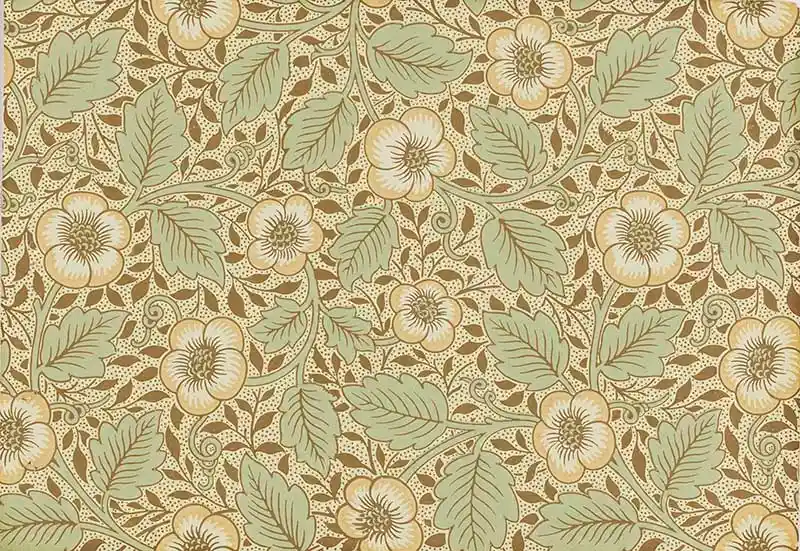
42 Daisy Wallpaper Green Colourway
A second sample of the daisy wallpaper is in green colourway.
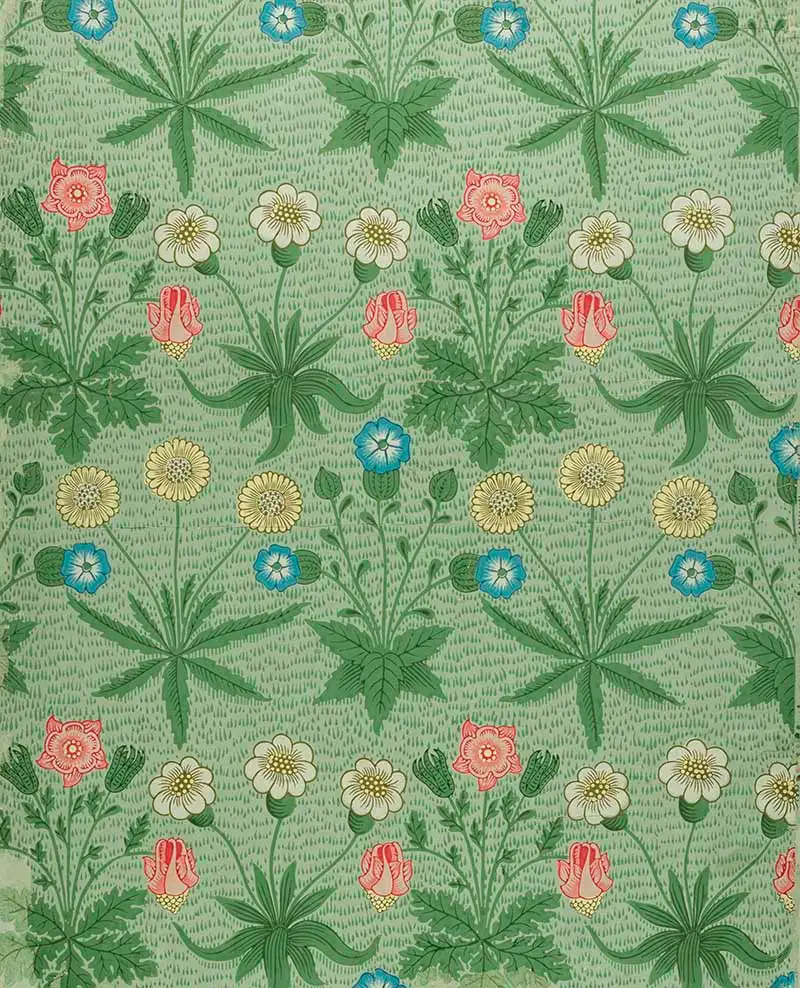
43. Fritillary
Fritillary is a delicate and graceful wallpaper design by William Morris, first produced in 1885. It features the distinctive bell-shaped flowers of the fritillary plant, woven into a soft, repeating pattern of gently arching stems and leaves.
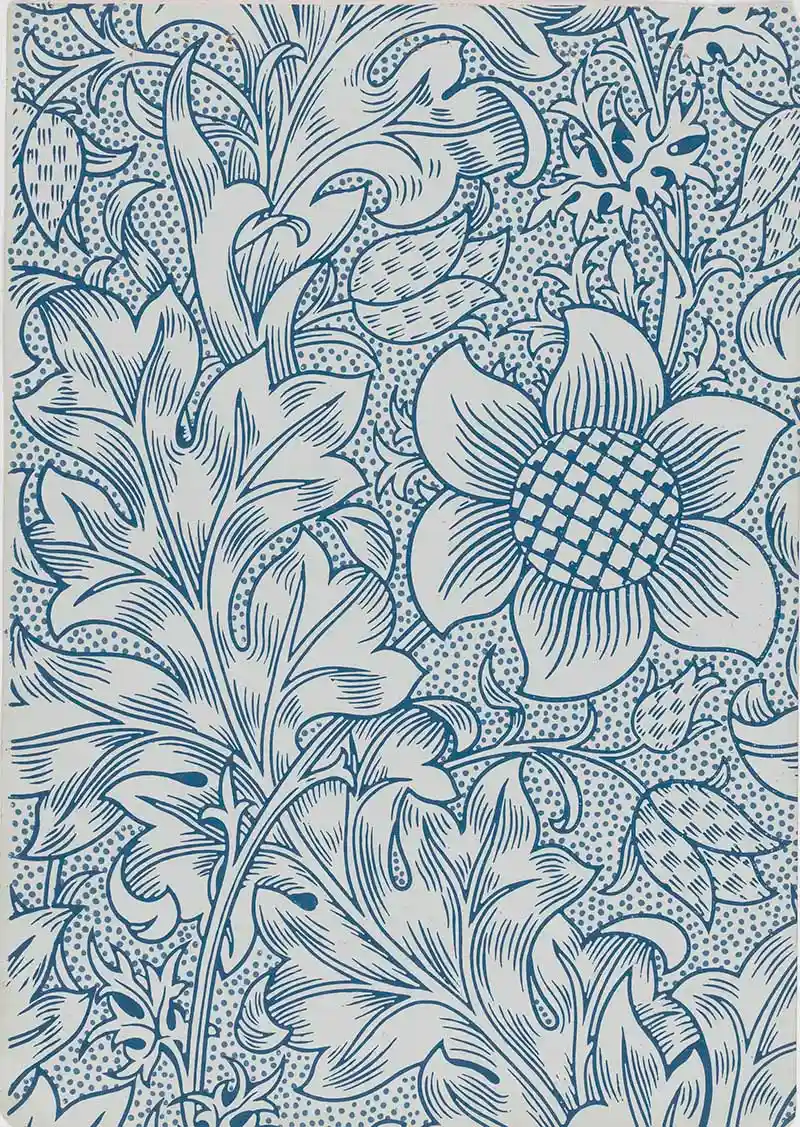
44. Apple
Apple is a classic William Morris wallpaper design created in 1877, featuring ripe apples hanging from leafy branches intertwined with delicate blossoms. The pattern is richly organic and balanced, with a sense of natural rhythm that makes it feel both structured and lively.
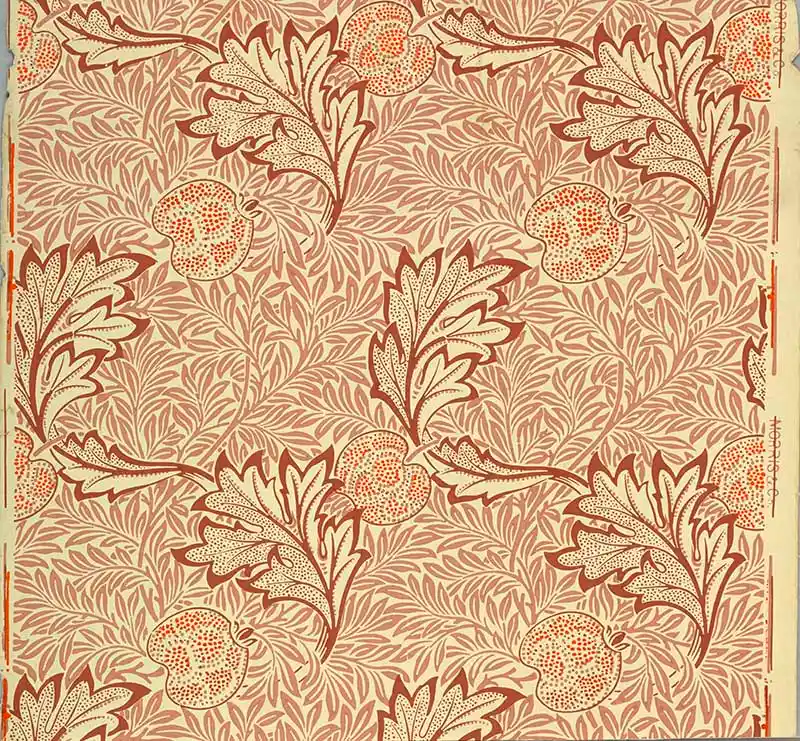
45. Cheshire Textile Pattern
The Cheshire textile pattern by William Morris is a richly woven design featuring a striking mix of large stylized flowers—resembling chrysanthemums or peonies—alongside curling acanthus leaves, trailing vines, and distinctive thistles.
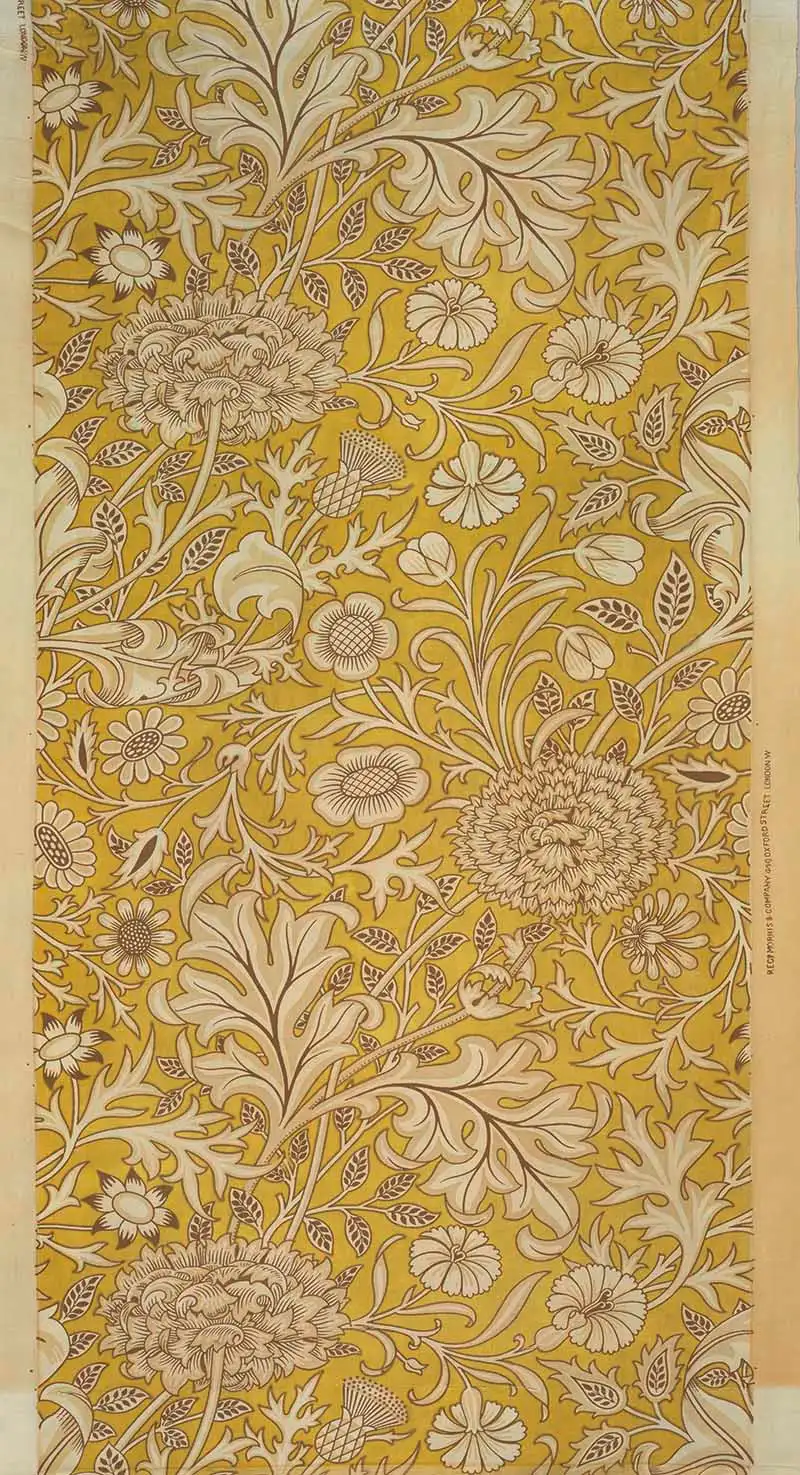
46. Rose
The Rose textile by William Morris, designed in 1883, features beautifully blooming roses intertwined with flowing foliage and delicate winding stems. What makes this pattern especially charming is the inclusion of small birds nestled among the leaves, adding a playful, natural touch to the romantic floral design.
There are some beautiful vintage rose illustrations on the blog.
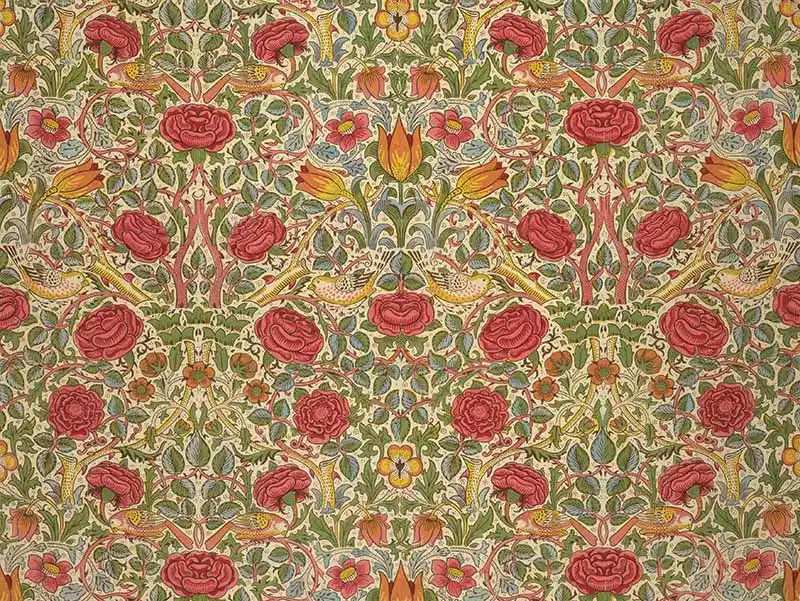
47. Kennet
The Kennet pattern by William Morris is a flowing, river-like design featuring stylized foliage, acanthus leaves, and delicate flowers, arranged in graceful curves that evoke the movement of water—reflecting Morris’s love of nature and named after the River Kennet in southern England.
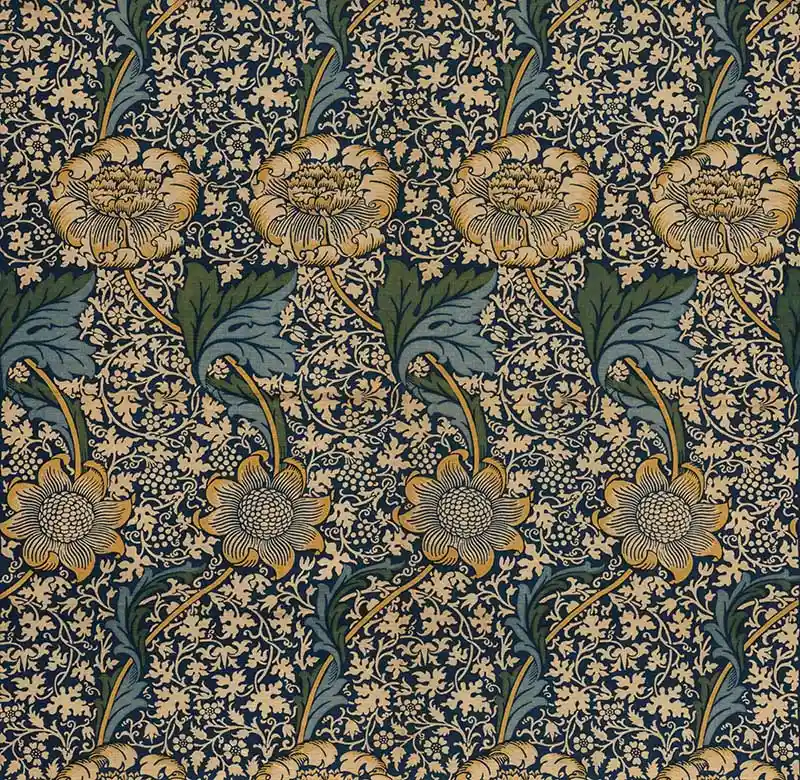
Other Pattern Collections
If you like William Morris’s wallpaper designs, check out Koloman Moser’s bold Art Nouveau wallpapers.
Christopher Dresser was a contemporary of William Morris, but he preferred industrial processes over handcrafted items. You may also like Seguy’s Art Nouveau pochoir butterflies or the posters of Alphonse Mucha.
If you enjoyed these beautiful patterns and designs of William Morris, check out some of these design collections on Pictureboxblue, such as Traditional Chinese Patterns, chinoiserie prints and Japanese Art and Design From the SHIN-BIJUTSUKAI.
Morris was influenced by Japanese art and design; you might also want to check out the Japanese vintage collection on the site.
If you want more botanical inspiration, look at the hundreds of botanical flower illustrations on the site. I especially like the British wild flower illustrations of Harriet Isabel Adams as she was trained in the Arts & Crafts style. There is a beautiful William Morris style Lily of the Valley pattern here.
These William Morris patterns would be great for home decor crafts, such as these DIY tile coasters.
William Morris influences many Art Nouveau artists like E.A.Seguy and his pochoir insect prints.
If you’re wondering what else you can do with these gorgeous patterns, check out these William Morris DIY air-dry clay ornaments on the site.
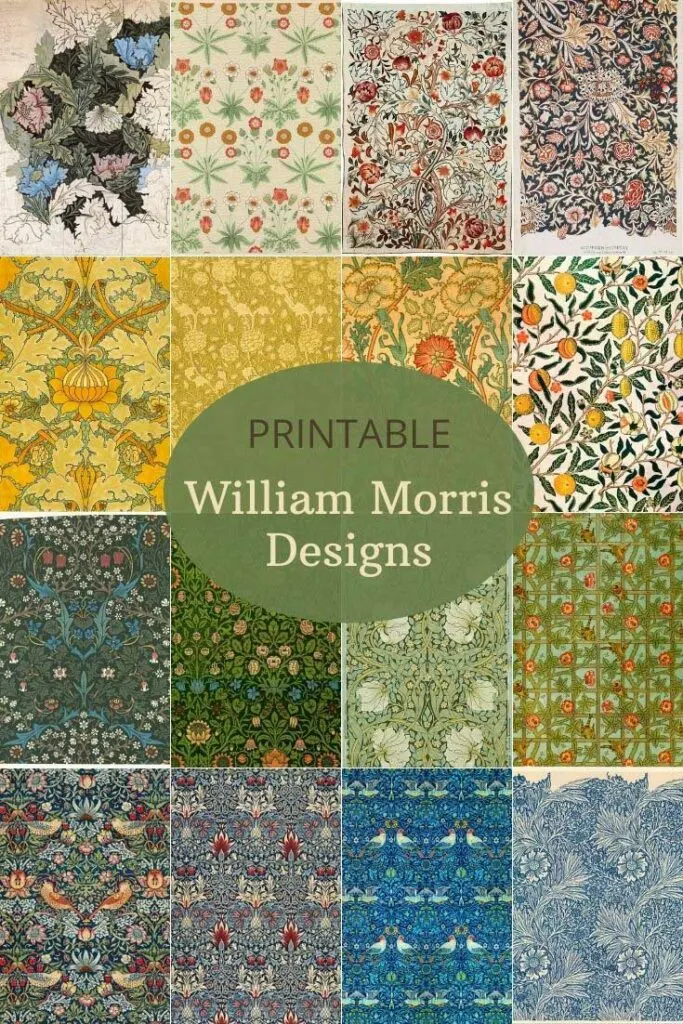
If you fancy, you can Buy Me A Coffee Here.
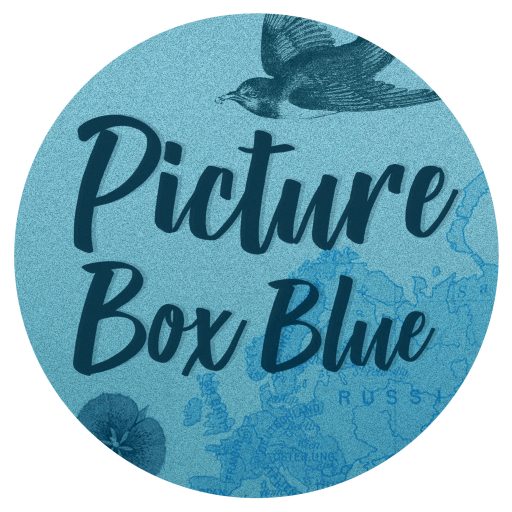
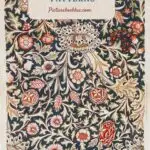
Kathleen
Thursday 20th of March 2025
Thank you for providing Willam Morris designs . The images we're printed beautifully
claire
Thursday 20th of March 2025
Your welcome, I will add more as I find them.
Louise
Friday 24th of January 2025
I've collected William Morris designs (in paper, fabric, wherever I can find it) for the past 3-4 decades. I can't get enough of his designs. I must say, your images here are the best I've come across online and they're of a decent size. Thank you.
claire
Sunday 26th of January 2025
Thank you, I always try to find the highest resolution images I can find. It's great to hear you find them useful.
HAMEL, CLARE LOUISE
Saturday 30th of March 2024
Love the William Morris 'Fruit' paper which comes in many different colour ways. Trying to find available samples of these (I live in NZ) is quite difficult. I would like to paper my bedroom in this pattern Thankyou so much for all the work you do posting wonderful images which are freely available to all online
Meryl
Friday 20th of September 2024
@claire, hi Claire, what size are these when printed out please?
claire
Sunday 31st of March 2024
Thank you. William Morris's paper is gorgeous, and I'm sure it will look great in your bedroom.
Patsy.
Wednesday 23rd of August 2023
Had many of these designs n many of our homes. Brings back many happy memories. Thanks for the show! 👏😊
claire
Saturday 26th of August 2023
Wow they must look lovely. Thank you.
Harjith
Monday 17th of April 2023
Thank you so much. These are beutiful
claire
Monday 17th of April 2023
Thank you, you're welcome